Receiving art with vulgarity

Painting: Faun and a Girl by Max Slevogt Source: Wikicommons
If vulgarity is unrefined or coarse then why do artists bother (if at all they do) intentionally imbibing it? Antonin Artaud’s “Theatre of Cruelty,” sought the ridding of humankind’s repressed energy and rejuvenating them as its purpose. Artaud says in his seminal work The Theater and Its Double (1938), “The theatre will never find itself again except by furnishing the spectator with the truthful precipitates of dreams, in which his taste for crime, his erotic obsessions, his savagery, his chimeras, his utopian sense of life and matter, even his cannibalism, pour out on a level not counterfeit and illusory, but interior.” The inherent repressed desires of mankind are realised through vicarious thrills—be it the gladiators in Rome combating to death, or twentieth century circus where women dressed in raunchy clothes and leaned their heads inside a lion’s mouth. One may smile, make faces or puke through the performance but the eyes want more!
In 1974, Marina Abramovic, a performance artist from Serbia created a performance called Rhythm 0. During the performance Abramovic became willfully passive and stood quietly in the gallery for six hours, during which audience members were invited to use one of 72 objects placed on a table to interact with her. The objects ranged from feathers, chocolate cake, roses, to a pair of scissors, a knife, a gun, bullets and chains. Initially, the audience started with placing a rose in her hand, kissing her, and feeding her cake. It was soon followed by taking scissors off the table and cutting off all her clothes, a man trying to rape her, another loading the pistol and pointing to her head, another man cutting her close to neck and drinking her blood. She stated, “After six hours, which was like 2 in the morning, the gallerists came and announced that the performance was over. I started moving and start being myself, because until then I was there like a puppet just for them, and at that moment everybody ran away. People could not confront me as a person.” 5 To see a silently standing artist, and however anointing or disfiguring her was at the audience’s discretion alone.

- Aamir Butt, “Manto: The tormented genius” THE NATION, January 18,2016,
https://nation.com.pk/18-Jan-2016/manto-the-tormented-genius - Navarasa: The nine emotions widely accepted in Indian art aesthetics
- The research was commissioned by Encore Tickets where the team monitored heart rates and electro dermal activity of 12 audience members at a live performance. The team found that alongside individual emotional responses, the audience members’ hearts were also responding in unison, with their pulses speeding up and slowing down at the same rate.UCL,” Audience members’ hearts beat together at the theatre” (November 2017),
https://www.ucl.ac.uk/pals/news/2017/nov/audience-members-hearts-beat-together-theatre#:~:text=New%20research%20led%20by%20the,you%20know%20them%20or%20not. - Freedom Cole, “The nine affects and the Navarasa” (March 2015),
https://shrifreedom.org/ayurveda/rasa-and-bhava/ - Natalia Borecka,“The Most Terrifying Work of Art in History Reveals The True Cost of Passive Acceptance”LONE WOLF MAGAZINE, April 16,2016,
https://lonewolfmag.com/most-terrifying-work-of-art-passivity/amp/ - Apsara: Celestial Nymph
- Bhavana Akella, “Khajuraho temples defined India globally as Kamasutra land” DECCAN HERALD,September 8, 2015,
https://deccanherald.com/amp/content/499793/khajuraho-temples-defined-india-globally.html
Acknowledgements:
About the author:
Vulgarity and the “Trashy” 80s: A Case for the Double-Meaning Hindi Film Song
Sporting a shabby sherwani and a comically large moustache in Manmohan Desai’s Mard (1985), Amitabh Bachchan, the brooding “angry young man” of the 1970s and 80s, sings provocatively about a bambu (bamboo stick) erected in a tambu (tent), as he longs to be united with his bride. As the song progresses, Bachchan unambiguously assigns the phallic symbol to the bambu and performs suggestive hand gestures that often originate from between his legs. The lyrics make up for what the gestures cannot say:
Maine Jor Lagaaya,
Haath Se Bhi Dabaaya,
Par Dil Ki Miti Na Chubhan
Dulha Baahr, Dulhan Andar, Bich Mein Yeh Gore Bandar
Mera Kab Hoga Utghaatan?
(I applied force,
Pressed with my hands,
But my longing does not subside.
I am outside, my bride is inside,
And these villains stand in my way,
When will my time come?)
Hum Toh Tambu Mein Bambu is only one of many such raunchy examples that populated Hindi films of the 1980s and early 90s. Though many of them were hits at the time, over the years the double entendre songs of this period have often been met with disdain, discomfort, and even righteous rage. The 1980s in particular incite such a reaction. Ahead of the 1982 Asian Games in New Delhi, the government had temporarily relaxed import restrictions for Video Cassette Recorders (VCRs) and coloured television sets, prompting the arrival of video cassette technology to India. The following years saw the mushrooming of “video parlours” across the country, where pirated copies of films were screened at much lower costs than movie theatres. At the same time, middle-class audiences retreated to their homes that were now equipped with coloured televisions and VCR sets. Exhibitors were at a loss and the industry entered a slump, engendering the perception that the decade represents a “dark age” in Hindi cinema. This perception is closely linked to the class composition of the audiences that frequented theatres during this period, based on the assumption that the poor cinematic quality is synonymous with “poor tastes” of the working classes. The films, made on sparse budgets, were considered exploitative and tawdry in production—certainly not an aesthetic that could find an honourable place in the neat trajectory of the Indian film history canon.
The “South Indian” Influence
A prominent trend in mainstream films of this period was the collaboration with Tamil and Telugu-language filmmakers. Based on interviews conducted with Hindi filmmakers during her doctoral research, Tejaswini Ganti observes a disdainful attitude towards this “south Indian aesthetic”, which was widely considered to be louder than Hindi films. The drama was regarded as kitschy, and the songs and choreography were seen as vulgar. But scratch the surface of this supposed vulgarity, and one may appreciate that some of these “trashy” song sequences are bursting at the seams with imagery. There are lovers dancing among flowers in deserted gardens or fields, married couples engaging in pre-coital banter, and several odes to the glittery adrenaline of the disco era. The double-meaning lyrics were often a play on youthful desires, premarital sex, and the pleasures of intercourse.
Dancing in lush fields in K Raghavendra Rao’s Himmatwala (1983), Jeetendra and Sri Devi sing:
“Kaisi yeh lagan hai?
kaisi yeh agan hai?
Milke mann bhare nahi, kaisa yeh milan hai?
(what is this attachment?
what is this fire?
The heart still yearns for more, what is this union?)”
The lighthearted song (Taki O Taki) gives expression to the burgeoning romance of young lovers who no longer wish to keep their desires secret. “Aapas mein taak dhin, taak dhin ho gaya, ab kya reh gaya baaki?” says the refrain of the song, loosely translating to: “we have done the taak dhin, taak dhin together, what more is left to do?”. The term “taak dhin”, used informally to mark beats in Hindustani classical music, becomes a euphemism for the pleasures of a love consummated—what more, then, is left to legitimise this union?
Jeetendra and Sri Devi in Taki O Taki, Himmatwala (1983). GIF created through GIPHY, Video Source: YouTube
The suggestive song sequences of the period also push the envelope in a largely censorious society. Looking at Bhojpuri cinema and vulgarity in the public sphere, Akshaya Kumar posits that vulgarity is also prompted by a desire to deliberately defy repressive rules of etiquette. To an extent, the mischievous double entendre in these songs is a test to see how far an idiom can stretch. The songs are careful to only make a suggestion, and are almost never explicit. Where there are limitations to what the text can say, they find innovative ways to convey meaning. In Aayi Aayi Mein Toh Aayi from Rao’s Jaani Dost (1983), Parveen Babi bites into an apple, then dances on grassy slopes with Dharmendra. She sings about the jannats (heavens) she hides within herself, as large, inflated balls descend down the hill. The visuals can lend themselves to any number of meanings—the apple is the forbidden fruit, and the balls (seemingly an odd choice of props) could mean a rush of hormones, or a burst of fertility. The cinematic text, therefore, operates at multiple levels.
Titillation of the “Low Brow”
The 1980s and early 90s were also especially rewarding for B cinemas—small-budget films that circulate in “non-prestigious” rural markets, often including sexploitation films, adult horror, and other “low” genres. This is the time when Marathi comedy icon Dada Kondke also made his foray into Hindi films, and brought with him the risqué humour he was known for in Marathi films. The song Teri Le Loon Baanhein from Kondke’s Tere Mere Beech Mein (1984) frequently makes it to online compilations of “most perverted” Hindi songs. The meter of the song has strategic punctuations which make the lyrics more salacious than if one were to read them on paper. The song features Kondke himself, and in a particularly bawdy line he says “khol ke mujhko dede, oh khol ke mujhko dede (open it and give it to me, oh open it and give it to me)”, before the next line clarifies “khol ke mujhko dede nakli kaano ki baali”—he is only asking the woman to remove her “nakli kaano ki baali” (false earrings) so he can replace them with genuine pearl ones.
Teri Le Loon Baanhein from Tere Mere Sapne (1984)
Filmmaker and writer Paromita Vohra has spoken about the middle-class disdain towards Hindi film song sequences, with recent trends moving away from the lip sync songs. Vohra identifies the 80s as the period where song sequences became “formulaic”, prompting an effort in the subsequent decades to discard the formula and usher in a mode of realism. Kondke’s suggestive number incites discomfort because of its crude approach to sex. The lyrics are unlike the sophisticated Urdu poetry of the previous decades, and the choreography lacks grace. This form, and the generally “camp” aesthetics of the decade, add further to the contempt with which Hindi song sequences are regarded. The pelvic thrusts, over-the-top expressions and “vulgar” lyrics of these songs constitute precisely the kind of “lowbrow” body genre that is considered excessive. It is, however, notable that even women perform these “ungraceful” pelvic thrusts and are often engaging in a cheeky back-and-forth within the same double-meaning song—subversive pleasures that politically correct criticism of the “exploitation” aesthetic often overlooks. Hardly anywhere else does the Hindi film provide such a free rein of expression—let alone depict the actual act of sex on screen—than in the film song. As scholars like Ira Bhaskar have argued, the film song becomes the “language of the ineffable”.
Vulgarity and Censorship
It does not take long for the notion of vulgarity in films to enter the ambit of the censorship debate. The most common concern about these double-meaning songs and suggestive choreography, from conservatives and liberals alike, is that they will influence impressionable groups poorly. This anxiety, of course, is premised on the elite belief that the illusions of cinema will corrupt the “poor, uneducated masses”. The particular disparagement reserved for Hindi films of the 80s and early 90s, Ganti finds, stems from the dominant belief that they catered to the “front benchers”—poor, young men associated with repressed sexualities and vulgarity.
The argument against this “vulgarity”, that it corrodes Indian morality, that it is “trashy”, or that it objectifies women; the judgement is often coloured by a censorious impulse to do away with something one disagrees with. This dismissal also discards with it any potential value the form may have offered. In 1993, Subhash Ghai’s Khal Nayak ran into major controversy over the song Choli Ke Peeche Kya Hai (what is behind the blouse?). The lyrics of the song combined with its visuals (of Madhuri Dixit dancing sensually in a room full of men) triggered accusations of vulgarity, objectification and titillation from different groups. But a closer analysis of the song also lends itself to a queer reading, where the song is essentially a conversation between two women.
Madhuri Dixit in Choli Ke Peeche Kya Hai, Khal Nayak (1993). GIF created through GIPHY, Video Source: YouTube
The latter half of the 90s saw a concerted effort to distance from the cinema of the previous decades. The economic liberalisation of 1991, and the subsequent “Bollywoodisation” of the industry—a term proposed by Ashish Rajadhyaksha in his seminal essay (2003)—ushered in glossier family dramas that catered to diasporic markets and NRI audiences. By 1997, the first multiplex had arrived, and the following years would see a greater indulgence of the tastes of urban middle-classes who patronised these establishments. More recently, a “realistic” form, sans song and dance, is taken to be the “thinking” person’s cinema, and the gateway to establish Hindi films as a legitimate and serious form. There’s less room for the sensory pleasures of a song sequence, or catharsis through an expectation to suspend disbelief, let alone for the “vulgar” flamboyance of the 80s—a period now largely perceived as what Ganti would call the “anti-thesis of cool”.
References
- Ganti, Tejaswini. 2012. Producing Bollywood: Inside the Contemporary Hindi Film Industry. Durham and London: Duke University Press.
- Kumar, Akshaya. 2015. Provincialising Bollywood: Bhojpuri cinema and the Vernacularisation of North Indian media. PhD thesis. University of Glasgow.
- Dutta, Amrita. 2020. Interview with Paromita Vohra. “How song and dance made love and desire visible on screen”. The Indian Express, July 12, 2020. https://indianexpress.com/article/express-sunday-eye/how-song-and-dance-made-love-and-desire-visible-on-screen-6500784/
- Muzaffar, Maroosha. 2018. “Interview: Ira Bhaskar on Lustful Ladies in Hindi Cinema, From Mughal-e-Azam to Veere Di Wedding”. VICE, 04 June, 2018. https://www.vice.com/en_in/article/ywen4m/interview-ira-bhaskar-on-lustful-ladies-in-hindi-cinema-from-mughal-e-azam-to-veere-di-wedding
- Subba, Vidhushan. 2016. “The Bad-Shahs of Small Budget: The Small-budget Hindi Film of the B Circuit.” BioScope 7(2) 215-223. DOI: 10.1177/0974927616668009
Header Image Caption: Sri Devi in Nainon Mein Sapna, Himmatwala (1983). Image screenshotted from YouTube
ABOUT THE AUTHOR
- Suhasini Krishnan is a student of Film Studies at Ambedkar University, Delhi. Her interests lie in popular Hindi cinema, the unique idiom of song sequences, and ‘Bollywood’ stardom as a phenomenon. She has worked as a journalist since 2016, and her writing has featured in The Quint, Homegrown, Times Internet, and Critical Collective.
The Phantom of Vulgarity around the Voluptuous Body
A complete break from defying conventional understanding of body and gender appears to be nearly unachievable. Often efforts to do so succumb to the brackets of dominant definitions, albeit unintentionally. In the context of Indian art history, the term fat is remotely invoked. The wave of presumption to measure the moral quotient in accordance with the “voluptuous” body was ushered in with the onset of the British Empire[i]. However, it is beyond the scope of this text to historically contextualise and trace the visual representation of the fat body of women across the genres in India. The ensuing discussion is an attempt to underscore the exhilarated interest of the art practitioners of the late nineteenth–twentieth century, especially in popular culture, to perpetuate the representation of the uncontained body as a site of mockery that further cemented fat-phobia, clinically termed as lipophobia.
A lost opportunity was the 2018 horror-comedy movie Stree. The movie received critical appreciation for its ironical undertones as it showcased men experiencing everyday challenges that are otherwise faced by women. Paranoia to take a late-night stroll, the need to follow appropriate dress code to avoid the male gaze, and the fear of being labelled a social pariah if the partner was chosen by the person and not parents are a few of the anxieties women are made to experience in the patriarchal societal structure. Within the satirical framework, the men of the region Chanderi are forced to step into women’s shoes as an act to ward off the invisible yet possible threats of the looming danger from the spirit Stree. Against the contingent of men, the movie about the subversion of the patriarchal discourse on women and social decorum has three women who make their presence on the screen, besides Stree (the apparition): Stree—led by Flora Saini; the lead protagonist—Shraddha Kapoor who is a protector-cum-witch; the one-time performer—Nora Fatehi; and the sex worker—Atmaja Pandey, who appears twice.
The movie, which wants to extend the feminist point of view, falters by representing its female characters through stereotypical bodily conventions. Instead of disturbing the social construct, the movie perpetuates the parallel between the body of the woman and her character. The discerning eye cannot ignore the synonymy of wasp waist with the sensuous charm and polite speech of Kapoor, and the fat body of Pandey with raw expressions and crass language. Even though the movie nudges its male characters to draw a new line of thought on feminism, it confines the female characters to a stereotypical formula. The non-adherence to bodily standards of a decent society, the fat body attracts the stare from the viewers of the comfort zone.
The movie, in an effort, to make the men get a taste of their own medicine remains woefully short to provoke us to see the world under a new lens stripped of bodily conventions. The consumerist popular culture opens an opportunity to navigate the contradictory approaches to derivative prejudices. Rather than having monolithic views feeding into confirmation bias, the multiple perspectives invigorate critical discussion. Under the satirical tones, the oblique treatment of the excess flesh creates a lacuna to be filled by another celluloid, free of the burden to make representation palatable to the larger audience.
Before Raja Ravi Varma’s representation of female divinities on oleographs, the goddesses as a manifestation of purity were sacred enough to be guarded against the public eye. Soon the mass production of the lithographs and oleographs in the nineteenth century heralded the way for mass art production, loosely termed calendar art. It promoted a standardised representation of woman-the semi-clad curvaceous body holding an odd posture.
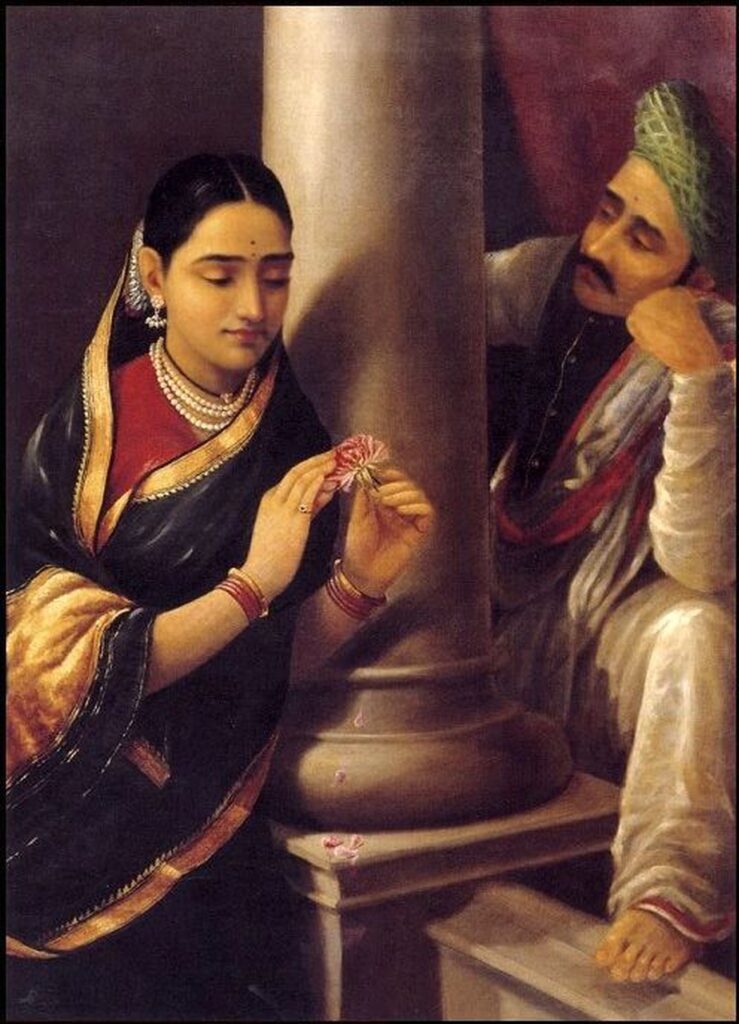
Image Credits: Stolen Interview, Raja Ravi Varma, Courtesy: Creative Commons
As the goddess was moved from within the walls of sanctity into the public sphere or bazaar, it turned into a profane woman and no longer a subject worthy of emulation. Exemplifying the same is the visual representation of Sakuntala and Dushyanta on a matchbox.
The Calcutta-based Parimal Ray collects an array of the paraphernalia of the bygone era’s popular visual arts—available at fairs, junkyards, and streets. In one of his collections, a matchbox carries the image of Shakuntala in a red-saree and the gesture of her hand pointed towards Dushyanta suggests refusal. If the traces of Varma’s stylistic approach to the visuals are not hard to ignore, it reinforces the “Swadeshi” flavour. Kajri Jain in her book Gods in the Bazaar explains the major critiques of the calendar art that has stemmed from the lithograph industry: “On aesthetic grounds, [this genre of printed image] has been condemned its derivativeness, repetition, vulgar sentimentality, garishness, and crass simplicity of appeal…” Conforming to the zeitgeist of the times, the image of Shakuntala, made popular by the lithographic prints, borders on the norms of domesticated modesty and unabashed display of desires.
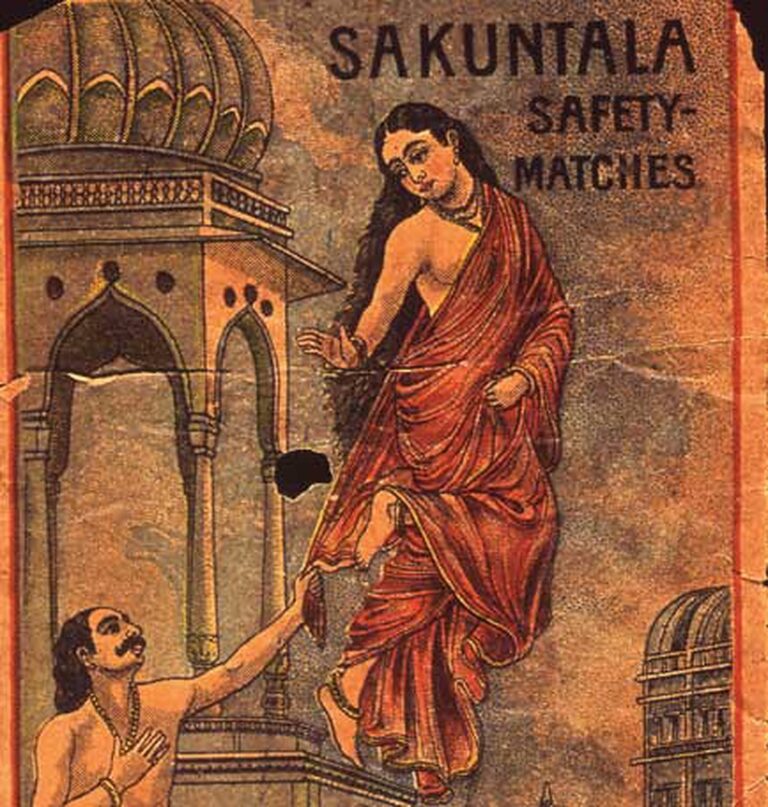
Image credit: Sakuntala, Matchbox Label, Early 20th Century, Courtesy: Parimal Ray, From the archive of CSSSC
The disjunction between the art period based on the temporal axis of tradition and modernity; access to the high or low art set the ground of aesthetic tastes: refined and vulgar.
The Kalighat paintings of the same time turned women into a spectacle for the commoners. The rose in the miniature art of medieval India served the purpose of both euphemism for and symbolism of representing the emotive sexual desires. Years later, the red flower in the hands of the so-called crass women in Kalighat paintings was reduced to a degenerative symbol of sexual advances: the domestically tamed flower is not to be turned into an immoral subject of public viewing[ii]. When the private acts of ease, leisure, and refinement are transmuted into the domain of public, it falls from the state of grace to debasement. Here, the metaleptic rose once again confirms the inherited frames of looking and perceiving the hackneyed representations of the epithet vulgar.
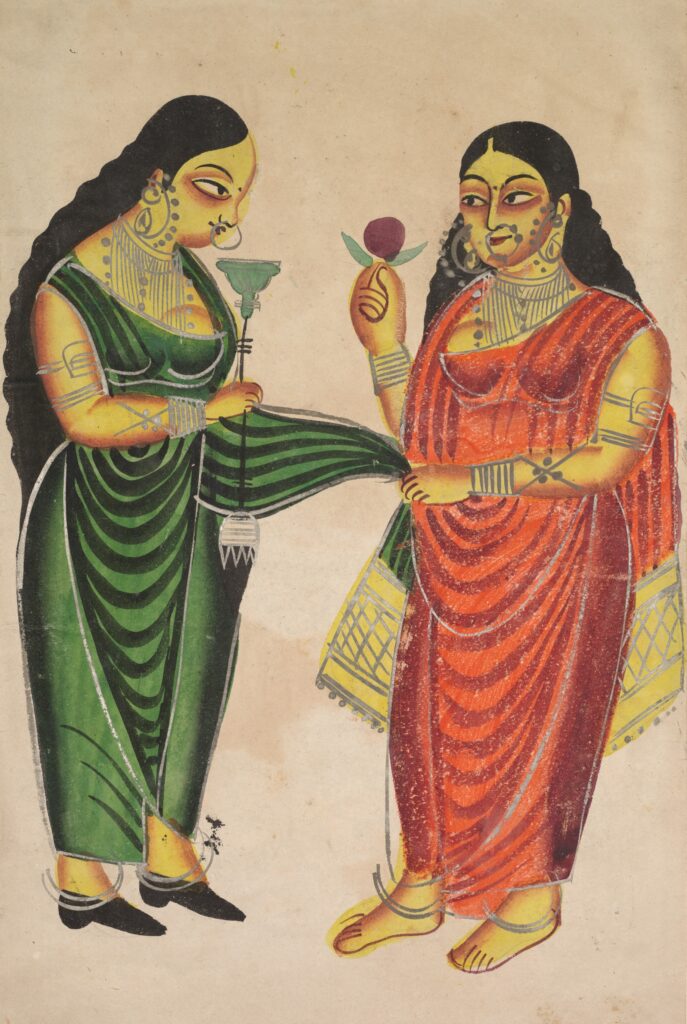
Image credits: Maid Bringing a Hookah to a Lady, Courtesy: Creative Commons
The critical discussion around fat female bodies as morally insufficient has remotely gained momentum in the western discourse of visual arts. It is predominantly an area of research interest for disciplines including media, cultural, and sociology[iii]. Despite academic scholarship, across the disciplines, on the body, especially in India, intellectual curiosity could not detach an array of adjectives from the body. More often than not, dissuaded as an object of ridicule, the dominant cultural discourse constructs a spectacle on the body that could not fit within the parenthetical appropriate measurements. To liberate the voluptuous body from the phantoms of the vulgarity, its visual representation devoid of clichés on the popular platforms is the first step forward towards a positive viewpoint. It is easier said than done. The necessity to reconfigure female fat bodies opens critical dialogue on the social construction of parallels between crassness and the uncontainable body.
It could be argued that visuals do not predominantly account for the fear of fat, the visceral responses to the desirability of wasp waist, which are embedded in the long social and medical history. Furthermore, the visuals are even dubbed as apolitical having little significance on the minds of the audience. Having said that, it cannot be denied that weaving in and out of the reversal chronology[iv] is the notion that the popular culture with these obsolete portrayals triggers an implicit bias. The importance attached to ‘what is framed’ and ‘why it is framed’ prompts to scrutinise the internalised behaviour of the immediate consumer of the popular culture—the audience. The regular engagement with the floating abundance of the visuals set the yardstick to measure the standards of body shapes and asinine behaviour. Subsequently, for the interpellated subject, the task to undo the epistemic structures is complicated when the surge of the visuals acts as a reification of truth in mainstream narratives. Hard to be removed from the site of public spectacle, the representation of the body is not exclusive to personal and political framework of assessment.
[i] Nead, Lynda. Myths of Sexuality: Representations of Women in Victorian Britain. Oxford: Basil Blackwell, 1988.
[ii] Archer, Mildred. Indian Popular Painting In The India Office Library (London), New Delhi: UBS Officer. 1977.
[iii] Snider, Stefanie, “Fatness and Visual Culture: A Brief Look at Some Contemporary Projects.”, Fat Studies 1, no. 1, (2012): 13-31.
[iv] Nietzsche, Friedrich, Werke, Translated by Schlechta. München : C. Hanser Verl., 1966.
ABOUT THE AUTHOR
Dilpreet Bhullar is a writer-researcher based in New Delhi, India. She has an MPhil from the University of Delhi in Comparative Literature. She is co-editor of the books Third Eye: Photography and Ways of Seeing and Voices and Images. Her essays on visual sociology, identity politics and refugee studies have been published in books, journals and magazines including Designing (Post) Colonial Knowledge: Imagining South Asia (Routledge), The Third Text (Routledge), South Asian Popular Culture (Routledge), Indian Journal of Human Development (Sage Publications), Himal Southasian, and the digital archive www.criticalcollective.in, to name a few. She is associate editor of the theme-based journal on visual arts, published by India Habitat Centre, and feature writer at
STIRworld.com
Drunkenness: A saga of derision and disgrace
Satyasoma: Pour this Goddess Liquor into a cup and off come the lovely dress and ornaments; reconciled are the quarreling lovers; made bold, the young; and full of life, the flirtations of love!
– Excerpt from Michael Lockwood and A. Vishnu Bhat,”Metatheatre and Sanskrit Drama”
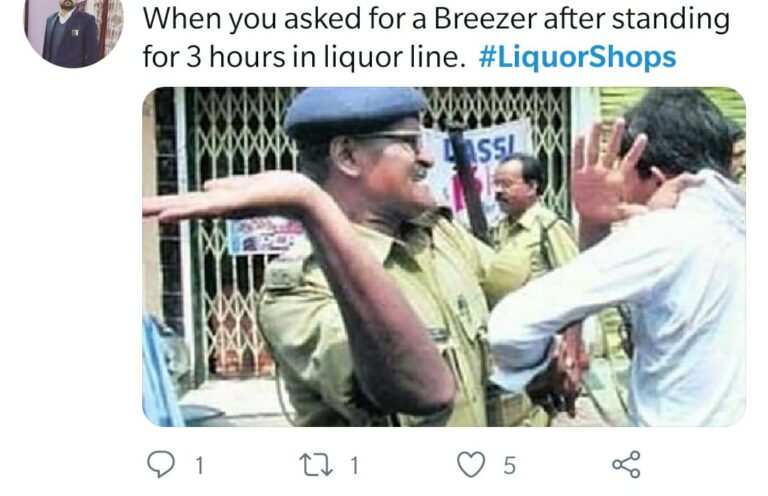
#LiquorShops Meme Source: Twitter
Comedy is evoked by scenarios of surprise, exaggeration, disproportion, shared awkward experiences, surrealism, irony, mockery, pun, or defiance. Henri Bergson says that a spectator would find contrived and mechanical movements comical. This is because they find it silly or absurd; essentially something which is considered abnormal in a society induces humour. Arthur Koestler says as humanity evolved, aggression was replaced with comedy. A comic situation arises only when the spectators don’t empathise, rather distance themselves from the characters. Comedy is also distinguished as high and low. It was commonly misconstrued that high comedy, which is witty and critical of life, is reserved for the educated. While low humour which entails bawdiness, silly visuals, drunkenness and physical humour, can be enjoyed by anyone.
Farce, a low form of humour is purely meant to induce laughter. The plot is set in an improbable situation, sometimes even incomprehensible. It is replete with absurd miscommunications and mistaken identities. The characters are stereotypical, often ignorant and belonging to lower social class[i]. Under these circumstances, a person under the influence of alcohol becomes an easy target for a protagonist.
A religious tradition which entails the practice of regular intoxication could have been an easy choice for a farce in the seventh century. Mattavilaasa Prahasana(m)/ A Farce of the Drunken Sport is a one act farcical play set in Kanchipuram. The playwright is the Pallava ruler Mahendra Varman whose epithet was Viciracittan, the man with the prowess of thinking unique. For an emperor who reveled under the idea of “thinking outside the box”, he penned two farces i.e. Mattavilasa Prahasana and Bhagavadajjuka[ii] which highly satirizes today’s heterodox traditions of South India. In Sanskrit theatre tradition, Prahasana—a farce, enlists a few characteristics—it is a one act play with predominance of low comedy. The object of laughter is improper conduct by ascetics, courtesans, rogues, etc. Unlike Hellenistic theatres, a farce in Sanskrit theatre incorporates elements of irony, satire, and mockery. It is essentially a lower form of comedy as it involves improper conduct—drunkenness in the case of Mattavilaasa Prahasana. These farcical plays could be marked as an innovation in Sanskrit theatre tradition, as there are no other renderings of farce available to the larger demographic. Satire usually comments on the hypocrisies in society or traditions. Hence, it can be assumed that the mentioned religious practices were prevalent during Mahendra Varman’s time[iii]. Mattavilaasa Prahasana gives a distorted idea of the religious tensions during the seventh century in Kanchipuram. This play, while bringing out the religious laxity and bigotry, there is an underlying tone of praise for Kanchipuram under the rule of the illustrious Pallava Empire.
The play’s characters follow three different traditions that are satirised i.e. Kapalika[iv], Buddhist, and Pasupata[v] tradition. In passing, the Jain tradition is also included. The protagonist of the play Satyasoma, follower of the Kapalika tradition, along with his wench[vi] Devasoma, enter the city of Kanchipuram visibly drunk. The beautiful city is in celebration as the two of them enter another tavern to drink more. They praise the tavern which is complete with drunken revelry, a paradise for the Kapalika. While collecting alms, the duo realise that their Kapala, the skull bowl is missing and nowhere to be found. Satyasoma concludes that it must have been either stolen by a Buddhist monk or a dog, as the bowl contained roasted meat. At this inopportune time, a degenerate Buddhist monk Nagasena, contemplating indulgence in intoxication or ritual intercourse, enters the scene and is accused of theft. After a few scathing remarks are exchanged, a drunken brawl ensues until Bhabrukalpa, a practitioner of Pasupata tradition tries to resolve the matter. Bhabrukalpa, also a degenerate, only wants to add fuel to the fire as Devasoma left him to be with Satyasoma. Bhabrukalpa praises the righteousness of the judiciary system under the rule of King Mahendra Varman. Just then a madman enters the scene carrying the skull bowl. After Satyasoma receives his bowl, he thanks Nagasena and Bhabrukalpa with respect and departs. While this play epitomises the Pallava reign, it outwardly berates religious practices, especially Buddhism.

Kutiyattam presentation of Mattavilaasa Prahasana(m) Courtesy Kalamandalam Sangeet Chakyar & K.K. Gopalakrishnan
Jessica Milner Davis comments “The comic spirit of farce delights in taboo-violation, but avoids implied moral comment or social criticism and prefers to debar empathy for its victims. This combination is vital for farce to succeed.” Under her categorisation, it is likely that Mattavilaasa Prahasana falls under Equilibrium or Quarrel farce where two opposing parties quarrel without resolution, restoring the same balance. While Satyasoma’s drunkenness is the crux on which the plot rests, the Buddhist traditions and philosophies are satirised and ridiculed. This could have been a significant taboo in the seventh century Kanchipuram. The playwright being a supporter of Saiva revival has brought out his thoughts about heterodox traditions through this text. The Buddhist complains about his traditions and wonders why Buddha has not included alcohol and ritual intercourse while allowing every other comfort. On the other hand the Kapalika not once dislikes his tradition, and he ruthlessly comments on Buddhist and Jain traditions. Satyasoma also compares a Buddhist monk to a dog trying to steal his skull bowl because of the roasted meat. In the end, it is a dog which runs away with his skull bowl. There is also a statement where the Kapalika says Buddhist tenets are stolen from Mahabharata and Vedanta. Usually the play is seen as a taint to the Kapalika tradition, it is more likely to be so on the Buddhist tradition which was on a slow decline. Nagasena only comments on Satyasoma’s regular drunken antics and tries to stay away but in vain. Satyasoma’s character is represented as a shallow drunk who slurs and loses his motor skills but the Kapalika tradition is upheld which is clear in the benedictory verses (Naandi Sloka). Throughout the play, Satyasoma’s drunken horseplay is used not just as a source of comedy but an easy reason to cast aspersions.
This play, when represented in Kutiyattam has a completely different connotation. Lord Shiva’s dance to appease the angry Goddess Bhadrakali is equated to Mattavilaasa Thirunrittam, the intoxicated dance. Even though there is a divine association to the protagonist, he still provides comic relief as a drunken man by exiting the stage looking for alcohol, leaving the audience light hearted.

Barney Gumble, The Simpsons Character
Created by: Jay Kogen & Wallace Wolodarsky
Source: Wikimedia Commons
Infusion of satire in a drunkard’s words has been a tool to question the society and its norms. Examples of this can be found across different theatre traditions, television series, and cinemas. Apart from Mattavilaasa Prahasana, drunken characters making a fool of them and taunting others are included in Nagananda, written by Emperor Harsha of the Vardhana Empire. In Twelfth Night, Sir Toby Belch mouths witty comments including his blatant disregard for drunkards even as he is one himself. Moliere uses drunkenness as a veil in a marital relationship. In Anton Chekov’s Drunk, drunkenness has been used as a means to reveal darkest personal secrets and in turn the societal perception of wealth. Barney Gumble from the animated television show Simpsons is always seen at Moe’s Tavern burping loudly, while the narrative also shows his life overturned by alcohol time and again; Tyrion Lannister from Game of Thrones whose sharp remarks on society are a few examples of the drunken double-edged jokes. Drunkenness has always been a source for easy physical humour where the character gets away with any comment they make under the garb of intoxication. While the character embraces low comedy, the resultant effect is satire or black comedy. To sum up, as Satyasoma befittingly says, the goddess liquor removes the embellishments and only reveals the truth, however loving, remorseful, or sardonic.
References
- Tolman, Albert H. “Shakespeare Studies: Part IV. Drunkenness in Shakespeare.” Modern Language Notes 34, no. 2 (1919).
- Donato Totaro, “Two Minds on Comedy: Arthur Koestler vs. Henri Bergson”. Volume 16, Issue 11-12 / December 2012 {https://offscreen.com/view/koestler_vs_bergson}
- Farrell, Joseph. “Fo and Feydeau: Is Farce a Laughing Matter?” Italica 72, no. 3 (1995). www.jstor.org/stable/479721.
- Gopalakrishnan K.K., Mattavilaasa Prahasana in Kudiyattam.
- Jessica Milner Davis, “From the Romance Lands: Farce as Life-Blood of the Theatre” At Whom Are We Laughing?: Humor in Romance Language Literatures, 2013 {https://www.cambridgescholars.com/download/sample/57921}
- Lloyd Murle Mordy Jr., 1965. Farcical elements in selected comedies of Moliere. {https://core.ac.uk/reader/33368734}
- Michael Lockwood and Vishnu Bhatt A., 2005. Metatheatre and Sanskrit Drama, Second Revised and Enlarged Edition. Tambaram Research Associates.
- Translated by Palmer Boyd, 1999. Nagananda – Harsha. In Paranthesis Publication, Sanskrit Drama Series. {http://www.yorku.ca/inpar/nagananda_boyd.pdf}
- Raghavan, V. “Sanskrit Drama: Theory and Performance.” Comparative Drama 1, no. 1 (1967). www.jstor.org/stable/41152424
- Edited and Translated by Unni N.P., 1974. Mattavilaasa Prahasana of Mahendravikramavarman. College Book House.
[i] The Three Stooges is a classic example for farce. There is no underlying plot, the characters are from a lower social class and there is a high usage of slapstick comedy and horseplay.
[ii] There has been an ongoing debate about the authorship of Bhagavadajjuka. This essay takes Michael Lockwood and A. Vishnu Bhat’s assertion of the playwright
[iii] Xuen Xang’s travelogue mentions the large number of Buddhist monasteries in Kanchipuram during the same time period
[iv] Kapalika tradition is a form of non puranic Shaivism. Traditionally they carry an empty skull bowl (Kapala) for alms. One of their rituals entailed alcohol consumption.
[v] Pasupata tradition is one of the oldest Saiva devotional and ascetic movement
[vi] N. P. Unni’s translation of Mattavilaasa Prahasana uses the term wench for Devasoma. She is probably called so as she changes her allegiance from Pasupata to Kapalika tradition along with changing her partner.
Header Image credit: Cover page of Mattavilaasa Prahasana by Dr. N. P. Unni, Nag Publishers Courtesy: K. K. Gopalakrishnan
About The Author
Kuzhali Jaganathan is an arts manager and a dance practitioner. She takes immense interest in studying cultural practices, and it’s reflection, and implications in arts and literature. Apart from being an MBA, she has completed courses on Buddhism and Tantric Practices. She aspires to be an academician.
Virile Desires? Scenes of ‘unnatural’ sex in Rajasthani paintings

The above image (Fig.1) seems to be a preparatory or practice drawing/sketch in which women are depicted sprawling their legs for a wild boar, monkey, black-buck, and a man for copulation. From erotic scenes adorning temple walls to “ass-cursed” stones (gadhegal) depicting a woman being penetrated by a donkey and beyond[ii], the expansive range of artworks depicting sexual activities give a glimpse into South Asia’s complex past, which has much to offer when we think of sex and sexuality. Likewise, Fig.1 makes us wonder: why was it created? Who was the spectator? In an attempt to understand these “unnatural” scenes, this essay offers a preliminary inquiry of this complex subject which remains understudied.[iii] The examples used here belong to the region of Kota and a brief overview of its artistic traditions and histories shall help us to understand the context of their production.
Fig.1: Erotic Vignettes of Intercourse of Women with Animals and a Man, circa 19th century, Kota, Rajasthan, India. Collection: Harvard Art Museums. Link: https://www.harvardartmuseums.org/collections/object/217581?position=3
Enveloped now within the state of Rajasthan in northern India, Kota, in 1631 CE was an independent princely state established by Rao Madho Singh (r. 1631-48).[iv] Painting as an activity at Kota arguably began as early as the 1650s. By the 18th century, Kota was one of the major centers of court paintings with accomplished artists executing a variety of subjects – sensitively rendered flora and fauna (most notably elephants), ecstatic hunt scenes and a wide range of surviving preparatory/practice drawings, all of it giving a glimpse into the artists’ psyche and lives.[v] Erotic scenes were a conventional theme among court painters. Kota painters never failed to convey the passion through their “undulating line[s]” as seen in Fig.2.[vi]
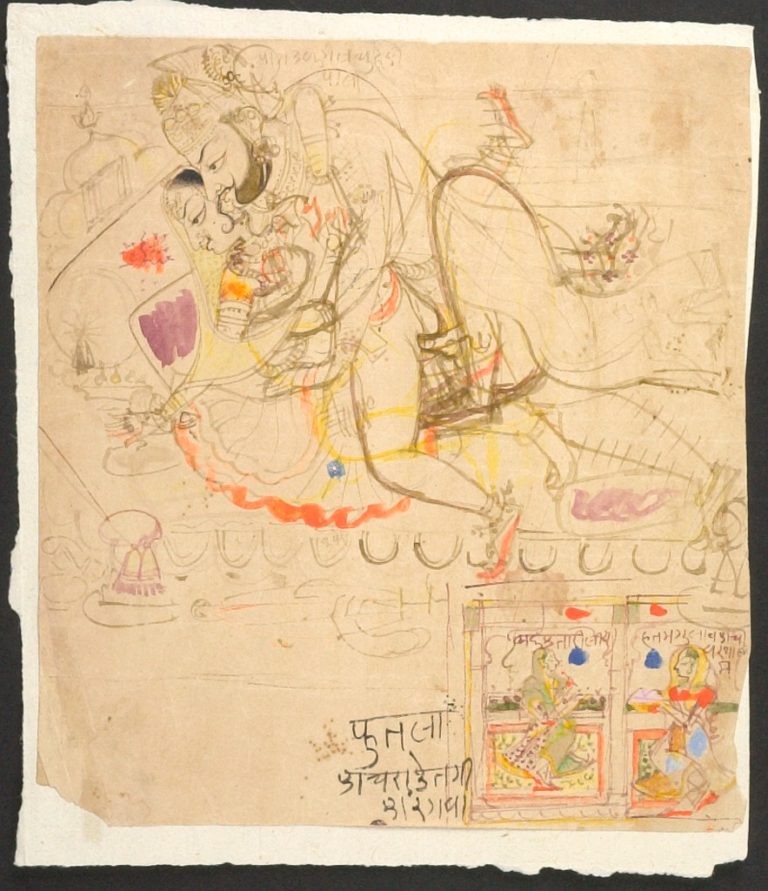
Fig.2: An amorous couple and two women, 19th century, Kota, Rajasthan, India. Collection: Harvard Art Museums.
Link:https://www.harvardartmuseums.org/collections/object/217615?position=41

Fig.3: The great orgy of Maharao Shatru Sal II, mid-19th century, Kota, Rajasthan, India. Collection: Harvard Art Museums. Link: https://www.harvardartmuseums.org/collections/object/310594?position=0
A better picture is available on Flickr: https://www.flickr.com/photos/heleenmeijer/41975279091/
Almost an expansion of Fig.1, the above scene is set against a dark dramatic gloomy sky with curling clouds, crowded with figures. Through the lush green mountain and the marbled palace-like structure, the painter distinctly splits the scene into two. Only a close inspection of the painting unravels this ‘potpourri’ – the upper part depicts a variety of animals and birds in copulation; parakeets, ducks, goats, tigers, wild buffaloes, camels, bull-cow, deer, sloth bears, dogs, horses, wild boars, nilgais, and even elephants. Slowly as our eyes move down, few male-animals and men are seen copulating with women in a variety of positions and “oblong pillows and small cups strategically placed to collect body fluids are scattered all over the lower half of the painting”[vii]. While some women seem to ‘worship’ the enormous penises of three bearded figures who could probably be ash-smeared saints, one in the lower right even performs fellatio on him.[viii] Amidst all this, on the lower right, a woman is giving birth to a child. So what do we make of all this?
I suggest, looking beyond this painting may guide us further. Broadly, in many Hindu traditions, kama (desire or sexual love) is one of the four important aspects of life[ix], and especially for kings, kama was their rajadharma (king’s obligation).[x] Among the texts on “eroticism”, Kamasutra (in Sanskrit; arguably circa 3rd century CE[xi]) of Vatsyayana is perhaps the best-known and may give us some clues regarding this scene.[xii] The classification of “hero” (nayaka) and “heroine” (nayika) in Kamasutra, encompasses a chapter on sexual typology divides men into hares, bulls and horses and women into deer, mares and she-elephants.[xiii] Bulls and horses are signifiers of virility and power. If read carefully along with the text, some sexual positions reveal similarities with the painting. For e.g. “a ‘doe’ positions herself in such a way as to stretch herself open inside”.[xiv] And “…When both thighs of the woman are raised, it is called the ‘curve’. When the man holds her legs up, it is the ‘yawn’…”[xv] (see Fig. 3.1, with numbers marked). This is not to suggest that Kamasutra is the direct source of this painting, but we should not be surprised to find the painting’s roots in this as many Hindu/Rajput rulers “reached back” to these texts (other examples include Rasikapriya, Gita Govinda, Ramayana among others) and were “deeply inflected” by early South Asian aesthetic and visual traditions, as Molly Emma Aitken discusses.[xvi]
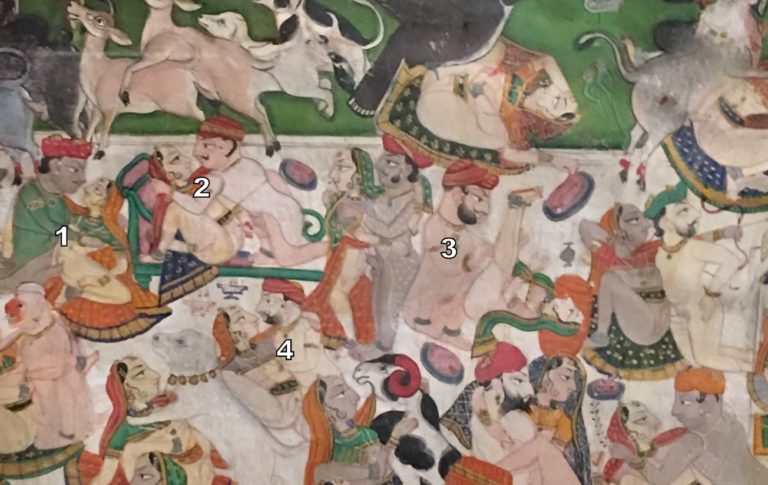
Fig.3.1: Detail from Fig.3.
Before we conclude, let us return to the painting. The scene almost camouflages an important figure on the left just above the blue figure. He is none other than the then ruler Maharao Shatru Sal II of Kota (r. 1866-89), who appears to be the most virile and powerful man among all in the scene (Fig.3.2). Another similar partly damaged scene depicts Shatru Sal II’s father Ram Singh (Fig.4).
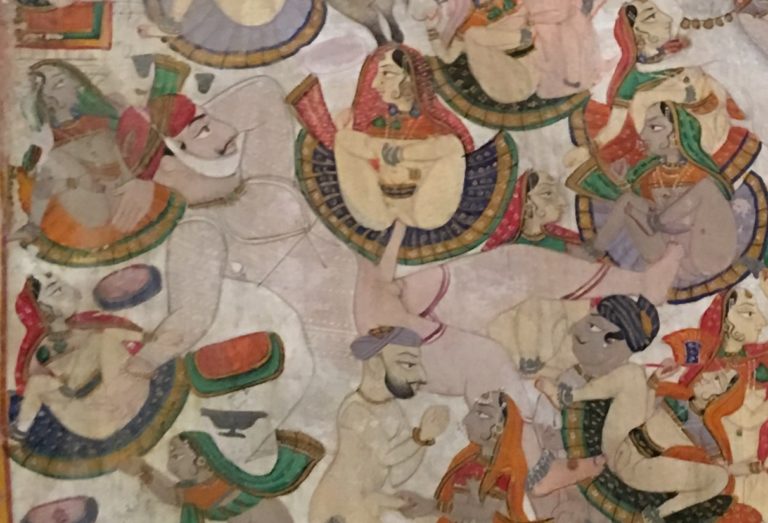
Fig.3.2: Detail from Fig.3
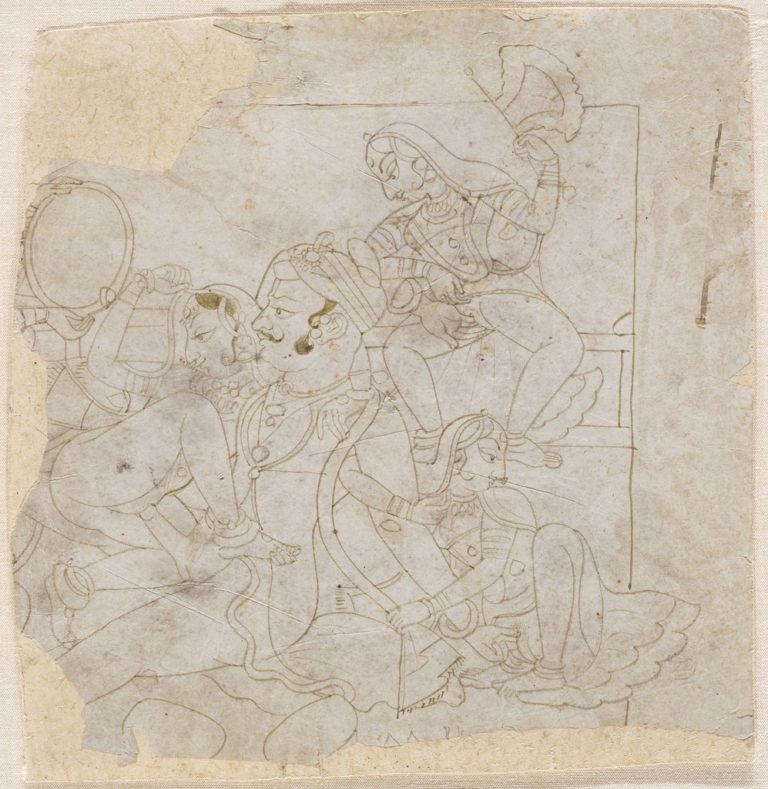
Fig.4: A Royal Figure and Several Courtesans Engaged in Amorous Activities, circa 1840 CE, Kota, Rajasthan, India. Collection: Harvard Art Museums.
Link: https://www.harvardartmuseums.org/art/217612
This not only confirms his prime position as an “ideal lover”, pleasing five women at the same time (something which no other figure is doing in this scene) but also his courtly masculinity and supremacy. Paintings were a powerful mode to convey such messages. In her seminal essay, Kavita Singh has argued how a Mughal painting of Muhammad Shah ‘Rangeela’ (r. 1719-48) might have served as a visual device to flaunt his lost virility after his “motor reflexes deteriorated at an early age, affecting his control over his lower body.”[xvii] Similarly, from circa 1877 CE, Maharao Shatru Sal II fell “quite ill and never really recovered”.[xviii] Could this be his way of expressing his sexual power? Besides, the continuity of the composition from father to son emphasizes their clan’s virility and legitimacy. Another comparison of the lowest part of the scene with an 18th century “gang-rape” scene from Mewar complicates this further.[xix] Molly Emma Aitken has published the below image (Fig.6) and a similar later version from Jodhpur. While examination of the entire scene (Fig.6) is beyond the scope of this essay, I agree with her interpretation, and offer a few thoughts – scenes depicting an “orgy” usually occur in an intimate setting of a palace or a terrace with a well-arranged bed/chamber including accoutrements to ignite passion and/or inclusion of signs of love like a pair of birds. With a rather dull background, this scene depicts a woman with legs sprawled while some men can barely wait for their turn; a figure in the lower right appears to be manscaping or performing circumcision or chopping off his own penis (perhaps a pun?) while others are violently fighting for their turn – this hints at the complexity which, I argue, goes beyond the conventional erotic or sexual scenes.
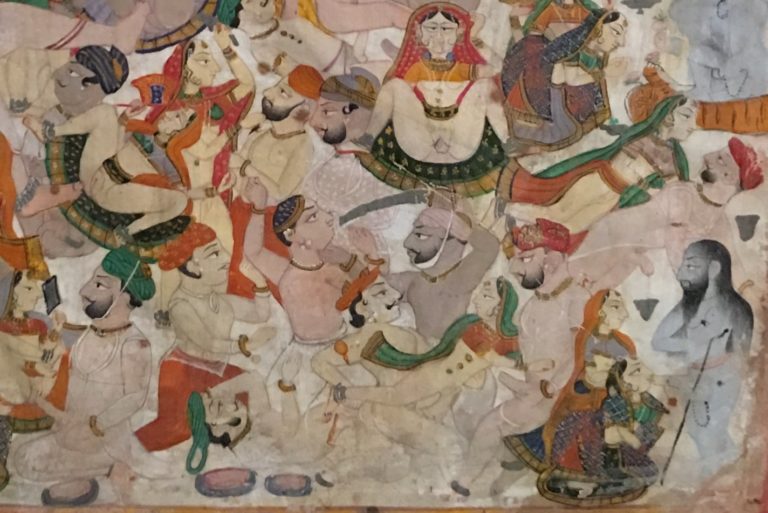
Fig.5: Detail from Fig.3
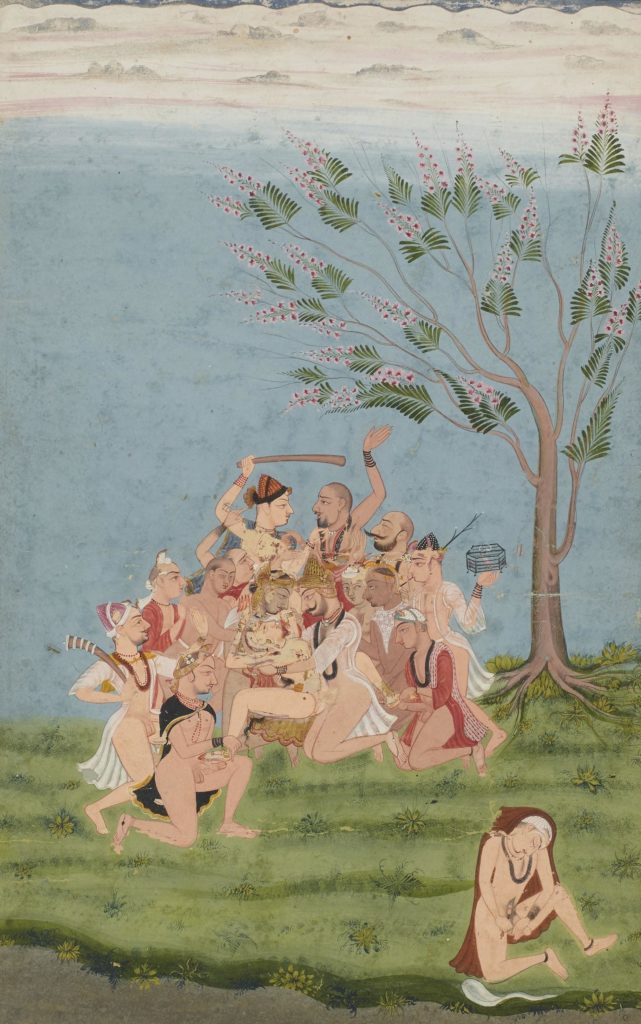
Fig.6: An Indian painting, circa 1740 CE, Mewar, Rajasthan, India. Source: https://www.uppsalaauktion.se/auktioner/?auction_name=20161206&catalog_nr=345
The practice of citing, quoting or copying of figure(s) and reusing compositions was common among artists, and following the explanation of Molly Emma Aitken , many of these compositions “were intended to create new meanings from their curious combinations….composite pages and marginal figures tended to invite the spectator to search for relationships among them and to create stories to justify their combination.”[xx] While it is possible that this quotation of “gang-rape” into this “orgy” was unintended or “lost in translation”, but “at the same time it seems likely that unintended connections were also a welcome part of the game of paratactic pictures”.[xxi] Does the inclusion of “gang-rape” hint on the horror of sexual acts?[xxii]
While the scene remains a mystery, any definitive answers at this point may result in a murky understanding of the layered world of South Asian painting. Instead, we would do well with meditating over why must we look at these?
Examining these “erotic fantasies” unravels the complexity of desires, especially in a pre-modern era. Not only these reveal how desires were understood in the courtly circles, it also gives a glimpse of how the artists envisioned it. I argue, here, the visual becomes a device to highlight masculinity and virility – one wonders if there is an exact textual source which is waiting to be discovered to further understand these complex paintings.[xxiii]
Acknowledgements:
This essay is an excerpt from my on-going research on sex and sexuality in pre-modern South Asian art. I am grateful to the Write|Art|Connect team for giving me this opportunity to pen down this essay and the editors for their feedback. I am indebted to Kavita Singh, Niharika Dinkar, David Gordon White, David Smith, Pronoy Chakraborty, Adira Thekkuveettil, Deepthi Murali and Aishani Gupta for their guidance. My selection and participation in the Likho Citizen Journalism Workshop (2018) aided me to look at gender more carefully – in particular, the guidance of Sonal Giani & Koninika Roy was helpful. Many conversations with Ruth Vanita have moulded my understanding of gender and sexuality in South Asia. This paper also owes much to the encouragement and feedback of Padma Shri Dr. Prakash Kothari (sexologist).
[i] This paper deals only with the scenes of ‘bestiality’ and ‘gang-rape’ in early modern South Asian painting. I have borrowed the term ‘unnatural’ from the modern legal lexicon of India. Trigger warning: Sexually explicit images.
[ii] For a general reading, see Dr. Alka Pande and Lance Dane, Indian Erotica (New Delhi: Roli Books, 2001). Also see Devangana Desai, Erotic Sculpture of India: A Socio-Cultural Study, 2nd ed. (New Delhi: Munshiram Manoharlal, 1985). On gadhegal, see K.F.Dalal, S. Kale and R. Poojari, 2015. Four Gadhegals Discovered in District Raigad, Maharashtra. Ancient Asia, 6, p.Art. 1. DOI: http://doi.org/10.5334/aa.12320. See Dr. Prakash Kothari, Erotica: The Art of Loving (Mumbai: VRP Publishers, 2010). An intriguing parallel of ‘unnatural’ sex scenes can also be found in Japanese Shunga. See Timothy Clark et al., eds., Shunga – Sex and Pleasure in Japanese Art (Leiden: Hotei Publishing, 2013).
[iii] It is also important to note that my examination is based only on the available photographs of the paintings from web sources.
[iv] Rao Madho Singh was one of the two sons of Rao Ratan Singh of Bundi. The rulers were from the Hada clan of Rajputs and bore the titles of Rao or Maharao.
[v] For a book-length study, see Stuart Cary Welch, ed., Gods, Kings, and Tigers:The Art of Kotah (Munich: Prestel, 1997). Also see the extensive scholarship of Joachim Bautze, Woodman Taylor and Milo Cleveland Beach.
[vi] Ibid., 20. Also see Natalia Di Pietrantonio, “Pornography and Indian Miniature Painting: The Case of Avadh, India,” Porn Studies 7, no. 1 (January 2, 2020): 36–60, https://doi.org/10.1080/23268743.2018.1532808.
[vii] Sunitha Das has examined this painting in a blog-article. She notes that the painting gestures towards Tantrism. My preliminary investigation has not yet given me any direct signs of Tantric rituals, but it is difficult to comment further before examining the in-person with clarity. However, David Gordon White has suggested to me that this scene has nothing to do with Tantra (email conversation, March 16, 2020).
See: https://www.harvardartmuseums.org/tour/women-in-south-asian-art/slide/10299
[viii] Again, there is no certainty about this and figures painted in light-blue may not necessarily be Shaivites but as they are also holding rudraksha mala which is especially seen among Shaivite figures, there is a possibility.
[ix] The other three being Dharma, Artha and Moksha. This varies in different sectarian traditions. See Catherine Benton, God of Desire – Tales of Kāmadeva in Sanskrit Story Literature (New York: State University of New York Press, 2006). A
[x] See Kavita Singh, ‘The Congress of Kings:Notes on a Painting of Muhammad Shah’. In Molly Aitken (ed.) A Magic World: New Visions of Indian Painting (In Tribute to Coomaraswamy) (Mumbai: Marg Publications, 2016). Also see Anna Jackson and Amin Jaffer, eds., Maharaja: The Splendour of India’s Royal Courts, V&A Publishing (London, 2009).
[xi] Dr. Prakash Kothari’s research dates the text to circa 351-375 CE.
[xii] While the term erotic or eroticism does not encompass the larger understanding of what these texts convey, it gives a basic understanding. Other notable texts include Rati Rahasya of Pandit Kokkaka, Ananga Ranga of Kalyanmalla. It is interesting to note that among all these, at least Kamasutra does not look at sex between human and animals in a positive light. An important read from a gender perspective, see Shalini Shah, Love, Eroticisim and Female Sexuality in Classical Sanskrit Literature: Seventh-Thirteenth Centuries (New Delhi: Manohar Publishers, 2009).
[xiii] See Daud Ali, Courtly Culture and Political Life in Early Medieval India (Cambridge: Cambridge University Press, 2006), 216; Vātsyāyana, Wendy Doniger, and Sudhir Kakar, Kamasutra (Oxford: Oxford University Press, 2002), 28-29. This is also repeated in Ananga Ranga.
[xiv] Doniger and Kakar, Kamasutra., 51.
[xv] Ibid., 54.
[xvi] See https://www.youtube.com/watch?v=D8fw_NmkSZc&t=776s
[xvii] See Kavita Singh, ‘The Congress of Kings:Notes on a Painting of Muhammad Shah’. In Molly Aitken (ed.) A Magic World: New Visions of Indian Painting (In Tribute to Coomaraswamy) (Mumbai: Marg Publications, 2016).
[xviii] Welch, Gods, Kings, and Tigers: The Art of Kotah., 56.
[xix] This and another version of a similar scene has been published in Molly Emma Aitken, The Intelligence of Tradition in Rajput Court Painting (New Haven: Yale University Press, 2010), 96. While she uses the two images to talk about how compositions are copied, her identification of both the scenes call it a “gang-rape scene”. Parallel scenes can be found in Japanese erotica (Shunga). See Kazutaka Higuchi and Alfred Haft. “No Laughing Matter: A Ghastly “Shunga” Illustration by Utagawa Toyokuni.” Japan Review, no. 26 (2013): 239-55. Accessed July 3, 2020. www.jstor.org/stable/41959826.
[xx] Molly Emma Aitken, “Parataxis and the Practice of Reuse, from Mughal Margins to Mīr Kalān Khān.” Archives of Asian Art 59, no. 1 (2009), 96.
[xxi] Ibid.
[xxii] Ibid., 99. Discussing a painting depicting intoxicated mystics and assorted subjects, she writes, “Tradition makes the divisions and their operations implicit. The viewer may be invited to wring from this spread of disparate scenes a meditation on intoxication: the intoxication of the lovers in the upper left, of the elephants in mast (intoxication) at the top, of the mystics on drugs, and of the victor in the hunt or in battle with his enemy.”
[xxiii] To add David Smith’s interesting take on this painting, “There can surely be no doubt that the painting was intended to have an aphrodisiac effect on its royal owner, to spur him on. The painting is certainly a representation of the universality of sexual love, where even asceticism denotes sexual power in a universe that is overwhelmingly sexual.” See David Smith, “Visual Representations of Aphrodisiacs in India from the 20th to the 10th Century CE,” in A World of Nourishment – Reflections on Food in Indian Culture, ed. Cinzia Pieruccini and Paolo M. Rossi (Milano: Ledizioni – LEDIpublishing, 2016).
About The Author
Based in Ahmedabad, Vinit Vyas works on early modern visual and material culture of South Asia, particularly court and devotional painting traditions. He graduated in Art History from the Dept. of Art History & Aesthetics, Faculty of Fine Arts, MSU Baroda in 2018. With an interdisciplinary approach, he also delves into religious studies, gender, sex and sexuality, languages, and text-image relationships. From 2015-2018, Vinit worked as a summer research intern at the Mehrangarh Fort Museum, Jodhpur, and has served as a visiting and guest faculty teaching South Asian art history at the National Institute of Design, Ahmedabad. He authored an introductory essay for the 2018 exhibition Luminously between Eternities and his other writings have appeared on The Heritage Lab, Sahagamana, and Virasat-E-Hind Foundation. Strengthening his research interests on Asian erotica, sexuality, and western Indian painting traditions, Vyas is co-authoring a catalogue on Rajasthani paintings and has also contributed a chapter in a forthcoming edited volume on the princely states of Gujarat.
The power and promise of the flip-word “vulgar”
The word “vulgar” evokes disapproval that may border on disgust; and it commonly runs top-down from the perspective of a beholder of self-proclaimed “finer” sensibility, casting judgment on objects and acts deemed “lowly”, “common” or “abject”. Since the advent of “classicism”, post-Enlightenment, which the Merriam-Webster defines as “adherence to traditional standards (as of simplicity, restraint, and proportion) that are universally and enduringly valid”, this perspective gains a renewed-validity and results in the imposition of a variety of corrective-measures. Measures, which aim to temper, reign-in and literalize the fluidity of lived traditions by adhering them to the “correctness” of an original text to reinstate past-glory; thereby driving the divide between the “classical” and the “common” even deeper, where the commoner is not only to be kept at an arm’s length but even held suspect and therefore to be controlled as his untamed and vulgar proclivities may well pose a threat to the project of (re)instating glory.
The use of the word “vulgar” along with its corollaries such as obscene, cheap, low-life, crude, tasteless, crass, indecent, indelicate, excessive, shameless, obnoxious, uncouth, etc. is not only subjective but also relative. It operates, rather effectively, as a gesture of distancing between the “refined” and the “crude” and conventionally remains the prerogative of the former. But what is of note here is that it may mean or imply quite differently from the perspectives of the “that which distances” and the “distanced”. As much as it tells us something about the identity of the object for which it is adjectively employed, it also gives us a glimpse into the mindset of the user. Through the prism of the word, both parties, the user and the receiver, become momentarily privy to attributes of the other; though, historically, only one perspective has been permitted and privileged, that of the caster of the word, the sophisticate. The word then comes to resemble a coin with equally valid flip-sides, except that in this case, the currency of the two sides might be unequal and they in turn may each foster a different set of corollaries.
Historically, the haves, the sophisticates, or the classicists have invented systems and created constructs that serve to continually undermine, devalue, marginalize, and even police the vantage point of the “lowly-other” along with all those who may seem different or idiosyncratic. Almost all Indian Reformers, in their earnest bid to reclaim lost civilizational and cultural “glory” made arbitrary distinctions between what they deemed “correct” and “incorrect” in Indian practices. This they did by adhering the practices to “lost-but-now-found” Shastras, plus tediously ridding them of influences that they considered aberrations caused due to “lower-instincts” of the commoners. The devadasi and the Hatha yogi in particular were direct casualties of such cleansing attempts to make Indian life “ideal” and “profound” once again.
What is important for us to register here is that this dream of the reformists was nothing new, it echoed the underlying drive of all “constructionists” who have through the ages been occupied in devising constructs to delineate and enforce the “ideal” upon the lived-life. The preoccupation of these constructionists, apart from the inculcation of “higher” and “refined” values has also been the “cultivation of innocence” and conformity among the common people, for the sake of their edification and upliftment out of the morass of their “lower instincts”.
Our ancient texts on aesthetics list things that may not be “shown” in literature or performance, the Sahitya Darpana, a 14th-century text by Vishvanatha Kaviraja lists a number of them, namely, battle, marriage, eating, cursing, death, amorous play, lying down, kissing, bathing, anointing to name a few. In nineteenth century, the Victorians in a bid to enforce stringent morality went as far as forming a décor-aesthetic, which was to drape the legs of chairs and tables. What is being controlled by such constructs are not the limbs of furniture but the suggestiveness of nakedness for fear of it exciting the lower instincts and triggering immoral thoughts and acts. So, it is a “suggestion” that is to be controlled; making both opacity and restraint the hallmarks of high or classical art and literature, and even interior design as we see in this example. Both of these, opacity and restraint, become woven into the pedagogy of the “classical” to stem out even the suggestion of that which might lead to the generation of ideas, images, mannerisms, and words considered unsavoury and immoral; and simultaneously to distance and police the other, i.e. the commoner, by attaching to them the derogatory “labels” of vulgar, low-life, common, cheap, even commercial and so on.
Chandraloka, a sixteenth-century text by Jaideva Piyushavarsha of Orissa, subdivides the term ashlila , i.e. vulgar, into three categories; these being vreeda , implying erotic acts that would embarrass or discomfit the modesty of the well-bred viewer or reader, jugupsa or disgust evoked by objects or acts considered abject and untouchable, and finally amangala, or things considered inauspicious such as death.
Rukmini Devi, the prime re-constructionist of Bharatanatyam dance categorically valorised bhakti, i.e. devotion over sringara, the amorous/erotic sentiment, both in her pedagogy and artistic works. For instance, freezing the movement of the hip, as it may suggest lasciviousness, became the hallmark of her style of Bharatanatyam taught at her institute, Kalakshetra. She painstakingly edited out the explicit verses of the traditional songs as well as the erotic gestures that were part of the devadasis’ repertoire as she considered them both vulgar and inappropriate for the use of the well-bred middle-classes; likewise, she rejected the devadasi-convention of biting the lower lip to depict the intensity of painful-pleasure; in the Mahabharata scene when Bhima slays Dushasana by tearing open his belly and pulling out his entrails, she did not subscribe to the Kathakali convention of pulling out a stream of red-dyed gauze hidden underneath the performer’s belt to enhance dramatic effect, as it seemed both excessive and violent to her; and in her choreography of the battle scene between Rama and Ravana in her epic-creation of the Ramayana, she chose not to depict the battle on the stage but had the dancing kinnaris or heavenly damsels describe the scene of blood and gore transpiring on the earth below from the skies above. I would say that she was not only following the dictate of the Shastras in making these decisions, but these were also her personal aesthetic choices informed by her taste, which to my mind remains unparalleled in refinement, her abhorrence for violence, as well as her idea of morality. I would also like to point to the fact that her aesthetic choices stay consistently shy of intense emotion and showing acts or mannerisms considered improper or abject.
I would now like to contrast these stipulations laid down by the Shastras and followed by not only Rukmini Devi but almost all reformers in every field and discipline through the late nineteenth and early-twentieth-century India, with the erotic poetry of Annamacharya (fifteenth-century) and Kshetraya (seventeenth-century). This Telegu poetry penned by men and sung by the pleasure women or devadasis is explicit both in its sexual as well as mercenary content. This poetry was the mainstay of the devadasi repertoire and its edited—by classical standards of restraint and opacity—version is still performed by Bharatanatyam dancers today in the form of padams, javalis and kirtanas.
Annamacharya, given the epithet of saint, writes suggestively about the woman’s body:
Don’t you know my house,
garland in the palace of the Love God,
where flowers cast their fragrance everywhere?
Don’t you know the house
hidden by tamarind trees,
in that narrow space marked by the two golden hills?
That’s where you lose your senses,
where the Love God hunts without fear.
And Kshetrayya continues in the same erotic vein:
You say, “Come close, my girl,”
and make love to me like a wild man, Muvva Gopala,
and as I get ready to move on top,
it’s morning already.!
And lastly, I cite an anonymous poem addressed to Lord Konkanesvara with bold sexual and mercenary content:
To sit by my side
and to put your hand
boldly inside my sari:
that will cost ten thousand.
And seventy thousand
will get you a touch
of my full round breasts.
Only if you have the money
Three crores to bring
your mouth close to mine,
touch my lips and
To hug me tight,
to touch my place of love,
and get to total union,
listen well,
you must bathe me
in a shower of gold.
But only if you have the money
So, what we have here are two well-documented sides of the stringent classicists-constructionists who advocated living by the book on the one hand, and the hereditary poet-performers on the other who freely wove their lived-histories and even their body’s “lowly instincts” into their art-making. Each is not only attractive in their own right but also equally repulsive to the other. Whereas the classicist vision may promise to fulfil our human dream of becoming restored, nay absorbed, unto a state of “untarnished-purity”; the sacred-erotic poetry emerging out of the abject-ethos of hereditary pleasure-women may offer a seamless experience of sensory-sublimity brought about through the distilled abstractions of their body, voice, tone, word, gesture, nuance, glance and style; and that too, within a safe-space tailor-made to un-normatively address the anxieties of intimacy and to unhesitatingly speak of things sexual in a manner and tone that may explicitly engage the body to lift the spirit of the rasika (aesthete) unto a buoyant-resolve where even the very possibility of intimacy may come into profound questioning. The truth perhaps is that both sides are in pursuit of the ever-nebulous middle ground, the madhyama avastha, where in the self may come into recognition.
However, the two sides remain ever mistrusting and severely judgmental of the other. While the former remains preoccupied with “textual-correctness”, the latter wrests the license and the capability to make and break their own rules in search of resonance; while the former holds deep-feeling in suspicion and even fear, the latter actively elicits a no-holds-barred engagement with the abjections of the body in search of a sensorially immersive poetic experience. We may have to concede that this conflict between the two is here is to stay, and the name-calling of the other is perhaps perennial in nature.
This name-calling based on mutual-repulsion brings forth corollaries befitting their perspectives around the flip-word “vulgar”. I have already listed the corollaries of the word vulgar from the distancing-sophisticate’s point of view at the beginning of this paper; from the perspective of the “distanced” or the one assigned to the margins, for whom knowledge may be derived not from the book but farmed out of the somatic intelligence and sensitivity of the body, it is the very “correctness” of the classicist-constructionist that is irksome. And from the margins this might appear to be too much of an idea, unbearably studied, image-conscious, un-lived, false, trite, literal, pedantic, didactic, flat, veneer, simulative, hollow, vapid, cheesy, appropriative, smug and so on. In other words, it might seem nothing short of a masquerade that apart from being fake and meaningless, may actually be defeating the very purpose of art, poetry, beauty, and resonance. A resonance that can only be born out of abstractions wherein the correct and the incorrect are freely allowed to co-mingle and disable the other.
To conclude I would like to say that it is of critical importance that in order to keep the middle-space of co-mingling alive, it is imperative to keep the space of the suppressed voice and the corollary-vocabularies of the distanced and marginalized alive and active. And even more important is to recognize the flip-sidedness of the name-calling words such as vulgar, because such words are powerful words, they are not only ploys for distancing, but can be vital tools to call out the bluffs of the other in order to challenge and tip the power-in equations for the purpose of opening a resonate space full of buoyant resolve. Because both within the subject and the object of the abject, there lies the promise of absence and sublimity.
Reference –
Ksåetrayya, When God Is A Customer: Telugu Courtesan Songs, Edited and Translated by – A.K. Ramanujan, Velcheru Narayana Rao and David Shulman, University Of California Press, 1994
ABOUT THE AUTHOR
Navtej Singh Johar is a dancer-choreographer, scholar, yoga exponent, and a social activist. A recipient of the Sangeet Natak Akademi award for Contemporary Choreography (2014), his work—within all fields of his varied interests—remains consistently body-centric. It twines practice with critical theory and social action, traverses freely between the traditional and the contemporary, and rigorously engages both the philosophical and the sociological discourses of the body. His choreography draws on plural vocabularies: bharatanatyam, yoga, physical-theatre and somatics, and has won critical acclaim both nationally and internationally. A research fellow at the, International Research Centre, “Interweaving Performance Cultures”, Freie University, Berlin, Johar teaches Dance Studies at the Ashoka University, India. Founder-director of Studio Abhyas, New Delhi, a space devoted to refining the processes of embodied Indian practices as well as examining their historical contexts, Johar has devised two pedagogical methods, the BARPS method, designed to practice asana more effectively, and Abhyas Somatics, a practice that aims to evoke rasa and sukha that are essential to Indian aesthetics and Yoga respectively.
Of Witnessing and Vulgarity: Anxieties of the photograph of violence
In beginning to think about photographs today, one is compelled to ask – has the photographic image become inherently unknowable? Evading categorisation, the ‘medium’ of photography – if it can even be referred to as such anymore – commands ingenuity in the words and vocabularies we accord to it. As our collective and cultural experiences continue to be shaped not by events but by images of those events, we are finding ourselves in an ongoing series of confrontational encounters with the photographic. Occupying increasingly complex positions as spectators within rapidly growing networks of dissemination, it makes sense for us to question the knowability of the visual inundation of the ‘real’ through photographic encounters.
Our present moment is overwhelmed by visuals of violence, matched in their intensity by our anxiety to remain awake and indignant, investing in socio-political eloquence on what we are witnessing and so fervently trying to remember. Incorporating the extraordinary as well as the mundane within its ambit, this is a witnessing of a fragmentation that spans the collapse of the familiar, across public and private spheres of our lives. Agitating at the crossroads of visual transience, moral righteousness, convenient access and proliferation, this remembering grows more and more ungraspable in its multiplicity. It remains fuelled by the fleeting nature of public memory and outrage as well as the erasures sustained by the state of governance. The witnessing we undertake and submit to then – both collectively and individually – is layered and deeply situated in circuits of mass visibility and manufactured response.
In its most threadbare association, a photograph is a fallible record of a very specific encounter with a landscape. This errancy expands beyond its material existence, residing as well in the interpretative possibilities that surround it. It is undeniable that our preoccupation in the moment is to ensure remembrance in the face of undeterred violence, an endeavour assumed with great urgency. It is only fitting that our keenest mode of memorialising the affect of this flammability is the photographic. However, the photograph of violence has slipped into a dangerous rhetoric of appropriation that prescribes distant condemnation, avoiding any engaged transmission of trauma. This makes the production of affect in a photograph a perpetual entanglement of sorts – outsourced by medium, maker and subject through multiple acts of (dis)balancing that are drawn across orality, tactility and even haptic response. Even so, understanding the extent to which affect is embedded in our world of objects and social relations thus becomes a heavy burden for anyone to bear. But how does this come to intersect with our capacities as spectators to violent, murderous upheaval?
Marianne Hirsch in her seminal work on postmemory and the Holocaust writes of a rupture – a ‘radical interruption,’ – a before and after of ‘seeing’ a photograph of violence that is traceable in the generation that survived the Holocaust and also the generation that followed it. Though images of survivors, perpetrators and victims of the Holocaust number in the millions across state and national archives, Hirsch highlights an archival repetition in the inheritance of trauma that persists in the photographs that came to be emblematically identified with the event. Transformed into icons of the event in their material and memorial prominence, these symbols of a violent, traumatic past place at stake a ‘guardianship’ of the same. Examining what appears to be a contradictory logic in this obsessive repetition of the same set of photographs, she notes a duality in the afterlives of these images for the second generation. The most obvious result of such repetition was of course the cultivation of a banality in representations of the Holocaust, but at the same, this also stimulated a (re)production of affect that allowed for a transmission of inherited trauma in a way that it could be processed and redeployed in new contexts of reintegration and remembrance. This second generation – the postmemorial one, as Hirsch terms it – attempts to gauge a coexistence alongside these photographs of violence, while at the same time seeking new avenues to reenvision and redirect their persevering ‘mortifying gaze.’
Continuing along this route, one is led to wonder about the dynamics of our own contemporary witnessings. Catapulted beyond what was previously a limited understanding of its material existence, the contemporary photograph of violence now exists across modalities of repetition and surplus, where either volume is harnessed in and through virtual accessibility and multi-media that have possibly subsumed the outreach of print. Across genre and category, role and usage, the photograph of violence is expansive in its connotations, and more often than not, serves a variety of negotiations with manifestations of vulgarity. Keeping with the tone of critical speculation that occupies most of our waking hours, it becomes necessary to think about our processes of navigating the obscenities that occupy the intertwinings of subjecthood and gaze, immediate context and subsequent retelling.
Thinking aloud, Hirsch wonders if we are truly past our points of saturation as Susan Sontag initially posited with regard to seeing and internalising such images, or whether there is a actually a possibility for these photographs to maintain and disseminate an ethical, expansive remembrance in the aftermath of such violence. However, the specificity of our spectatorial condition could be understood as two-toned, encompassing a complicity in convenient silences but also a determined unwillingness to not let the resilience of our collectivity be co-opted by institutionalised, state-sponsored regimes and/or colonially narrow spaces of remembrance.
In ‘The Civil Contract of Photography,’ Ariella Azoulay demonstrates the role of photography as a key political instrument of emancipation in zones of conflict, focusing on the regions of Israel and Palestine. Observing the development of photographic practices in and around such zones, she theorizes the creation of conditions of inclusivity, responsibility and action outside of the regulatory surveillance of the governing state that have been catalysed by the political arena of visibility and reclamation enabled by photography. Grounded in a shared civic space of relations created by photography and its networks of circulation, Azoulay’s discussion of photographs of violence establishes the possibilities within meaning-making and remembrance to overturn what is seen and accepted within a frame.
Hulleah Tsinhnahjinnie in ‘When Is a Photograph Worth a Thousand Words?’ writes of her encounters with the ethnographic Native American subject, documented as a stereotype, frozen in a foreign gaze and inside the ‘expert narrative’ of anthropology. She invites us to consider complexity in the ‘photographic sovereignty’ of a subject, receiving the gift of context as she does through an aboriginally-based, indigenous perspective. She cites philosophies and beliefs that she grounds in her Native culture, reiterating a non-conformity to allegedly ‘objective’ processes of observation that glorify, simplify and exoticise aboriginal uniqueness.
Photographs of violence that document the death and massacre of Native American spiritual leaders rarely coincide with evidentiary retellings that further reiterate the reality of the violence itself. She looks upon an image of the leader Big Foot killed at Wounded Knee, lying frozen in the snow – a photograph of violence, remembered through an archival veil of hopelessness. Reading perseverance into Native American spirit and the power of their survival, Tsinhnahjinnie’s chosen grammar of encountering such photographs of violence transgresses the realm of literal translatability that simplifies the deeply spiritual realities of Native American society. Taking her meaning-making to a space which is familiar to her – into dreams and their implicit meanings – she writes to evoke a specificity of indigenous religion and existence that shuns the seemingly rational readings of such acts of violence. Acknowledging callous misrecognition in the anthropological archive, Tsinhnahjinnie performs her space of remembrance outside of the delimits of isolation and imperial fixity, calling instead for the mutability of vocabularies in the reading of such photographs of violence.
However, the photograph of violence has slipped into a dangerous rhetoric of appropriation that prescribes distant condemnation, avoiding any engaged transmission of trauma. This makes the production of affect in a photograph a perpetual entanglement of sorts – outsourced by medium, maker and subject through multiple acts of (dis)balancing that are drawn across orality, tactility and even haptic response.
Drawing attention to the weapon-like violence of the apparatus, Teju Cole writes that in speaking of “shooting” with a camera, we are acknowledging the kinship of photography and violence. In combating the manipulations within the colonial, imperial gaze and its implications of the violence of extraction and erasure, we are urged to think of what remains in the aftermath of a photograph: possibly the vulgarity of audacity, of encoded yet unacknowledged power relations. To think outside this imperial understanding is, as Azoulay says, to “not let the photograph, a contingent product, overshadow the complex nature of the encounter out of which it was taken nor to blur the inequalities, the patterns of exploitation, and the incommensurable expectations, aspirations, and modalities of participation inherent in a photographic event.”
Is it possible then to envision a potentially adaptive vocabulary for the photographic, thinking of a ‘tendency’ instead of an arbitrary and absolute fixation on category? Our witnessing and its deployment of photography demands a willingness of words and meanings to accommodate fluid occupancies, hazards, possibilities and domains of the photographic image of violence in all of its unknowability today. Taking into cognizance the many historical trajectories of the photographic – its imperial and non-imperial potential – our present moment calls for a more intuitive stance towards it, inviting and identifying its fluid, evolving capacities and its conflations with a series of violence.
Most of the violence that we are witnessing and will eventually continue to remember so vividly, are encounters that have already shaped our political consciousness in some way or the other. Moulding our future ability to respond, react and contribute, this shaping offers a preemptive mediation of experiences yet to occur. However, this does not imply an easing of intensity or affect – instead, this anticipatory quality complicates the either/or dynamic of traumatic continuity and rupture. How do we begin to comprehend the dimensions of our own desensitisation against the relentless nature of what surrounds and implicates us?
Photojournalistic reportage contains the free-flowing ability to incite as well as execute, where photographs of violence wield opinions, whetting and dampening public outcry. We can find examples of this in the profanities of war and murder garlanded by state-sponsored violence in our national capital and in the coupling of visual and textual vocabularies that cite the framing of a brutal police state at the precipice of genocide. Despite our privileged political conspicuities, Cole states, “…photography implicitly serves the powers that be.” The greater good is a tangible delusion that contemporary photographic practice often leans towards especially in its documentary tendencies; our rememberings of these violent events, documented in the photographic should not merely aspire towards an archival remembrance that will underline their centrality to our moment. They should also serve as reminders of how photography continues to be mobilized, racialised, fetishised against certain communities.
Writing on black futurity, Tina M Campt highlights the refrain that remains at the core of black feminist activism today that is in throes of losing a generation of youth to state-sponsored disposability. This forfeiture, as she calls it, veils the future but is also deeply affective to the present. Our encounters with photographs of violence are constantly being transfigured because of the uncomfortable continuities that we are witnessing between our immediate present-becoming-past and a shifting future that is spiralling out of hand, away from any semblance of predictability. Acts of amplification that harness the divisibility and sheer expanse of media must remain vigilant, not dullened by momentary placations or tempted by sensationalism. The power of the photographic to interpellate must not and should not be underestimated and overlooked; instead by utilising this capacity, we must equip our spaces and acts of remembering with flexibility and sensitivity. Recognising the efficacy of ‘tendencies’ in meaning-making, to foster fluctuation over rigid, reifying fixation. Inclinations, leanings, impulses – willing to acknowledge lacunas, willing to pause and reconsider, incorporating divergent genealogies of meaning over authoritative, absolute definition. Resisting the vulgarity of scale, of spectacle and of ignorant complicity, to be met with refusals that persist through a solidarity in remembering self-reflexively.
Where do we place the aftermath in a temporal logic that resists sequence? What remains? What does this remnant do to the archival tendencies of the photographic, of any such documents of violence? How radical must our reimagining be of both the act of archiving and the archival space of remembrance itself? How do we begin to conceive of such spaces to ensure we eschew tautologies of relevance and superior narrative? With violence that threatens to overwhelm sensorially, emotionally and physically, the inadequacies of our failing vocabularies of definition and description call for a much needed overthrowing of archaisms between word and image.
An evolving spectatorship could entail a redefinition of the site and syntax of the ‘gaze,’ especially in the ways in which it is directed at photographs of violence. By aiming to destabilise in part the cultural determination that structures our gestural reactions to violence, we would, as Margaret Olin writes, be able to elicit a much-needed subversion of perspective in order to subvert the gaze. Having historically limited our readings of photographs to the detached virtuosity of a singular sensory register, we are still hesitant to recognise what we behold, and the intensity of what it evokes in us and our witnessings. To imagine proclivities of responses within our estrangement to and our rootedness in multiple realities and their simultaneous occurrences, would it help to try and reevaluate the encounter theorized as the ‘gaze’ in its own capacity to elicit sentience?
We might realise it necessary to pause now and acknowledge that in our acts of seeing, looking, watching and listening to the photograph of violence, we are also witnessing each other in the throes of coincident anxieties. Ours is a witnessing angled towards hopeful, creative emancipation, a fierce yearning to coalesce, converge, collect in the foreground of a temporally evasive before and after.
The poet Wallace Stevens writes,
After the leaves have fallen, we return
To a plain sense of things.
The question is, will we?
Authors Bio:
Annalisa Mansukhani studies histories of photography and notions of the archive in contemporary curatorial and research practices. She is currently fascinated by evolving vocabularies of imaging trauma across mediums in art. As a Programmes Manager for the Foundation of Indian Contemporary Art in Delhi, she works to establish frameworks and activate resources around art and education, spaces of exhibition, critical writing and public programming.
References:
- Azoulay, A., 2008. The Civil Contract Of Photography. The MIT Press.
- Campt, T., 2017. Listening To Images. Duke University Press.
- Cole, T., 2020. When The Camera Was A Weapon Of Imperialism. (And When It Still Is.). [online] Nytimes.com. Available at: <https://www.nytimes.com/2019/02/06/magazine/when-the-camera-was-a-weapon-of-imperialism-and-when-it-still-is.html> [Accessed 3 June 2020].
- Edwards, E. and Lien, S., 2014. Uncertain Images: Museums And The Work Of Photographs. Routledge.
- Edwards, Elizabeth. 2012. “Objects Of Affect: Photography Beyond The Image”. Annual Review Of Anthropology 41 (1): 221-234. doi:10.1146/annurev-anthro-092611-145708.
- Hirsch, M., 2012. The Generation Of Postmemory. New York: Columbia University Press.
- Martinez, E., 2020. Navigating The River: The Hidden Colonialism Of Documentary. [online] International Documentary Association. Available at: <https://www.documentary.org/feature/navigating-river-hidden-colonialism-documentary>.
- Olin, Margaret. 2003. “Gaze”. In Critical Terms For Art History, 2nd ed., 318-329. Chicago: The University of Chicago Press.
- Prevost, L., 2020. Power And Perspective In Storytelling: How To Support Each Other, Authentically Represent Characters, And Dismantle The White Power Structure
| Filmmaker Magazine. [online] Filmmaker Magazine. Available at: <https://filmmakermagazine.com/104047-power-and-perspective-in-story-telling-how-to-support-each-other-authentically-represent-characters-and-dismantle-the-white-power-structure%e2%80%a8/#.Xtc3Ep4zZQJ> [Accessed 3 June 2020]. - Tsinhnahjinnie, H., 2003. When Is a Photograph Worth a Thousand Words?. In: C. Pinney and N. Peterson, ed., Photography’s Other Histories. Durham University Press.
Technology, Obscenity, Leisure: The Case of the TikTok Ban
It took a ban for TikTok to really become an object of interest for the mainstream media. On 3 April, 2019, a bench of the Madras High Court passed an interim order directing the Centre to prohibit further downloads of the TikTok mobile app; to prevent broadcast media from sharing content created on the app; and to consider provisions for the safeguarding of children’s privacy online on the model of the Children’s Online Privacy Protection Act in the US. In the steady uptick of reports, opinion pieces and explainers that followed the banning of the app, it became evident that a cultural object that had caused sufficient consternation among members of civil society and lawmakers as to warrant urgent regulation, had actually passed below the radar of many. Recurring themes emerged in this press coverage – how TikTok had lately emerged as the favourite pastime of youngsters; how it had become a source of a new crop of influencers and content creators; and most crucially, how its domain had so far remained limited to the Indian small town, or to put it as one commentator did, evidently addressing an elite readership, “non-PLU types” (People like us). What became apparent in this retrospective effort to make sense of the app, was that a technological artefact charged with “encouraging pornography”, “degrading culture”, “causing paedophiles”, and spreading “explicit disturbing content” did not have the uniform cultural salience the High Court judgement would suggest. One cannot imagine, for instance, a similar flurry of explainers of what Instagram or Facebook is in the unlikely event that either social media platform were banned. It is in this contradiction between the app’s simultaneous popularity and anonymity that the anxiety around TikTok and its cultural invasion can be better understood.
There are precedents for this latest moral panic around a piece of technology. William Mazzarella has written extensively about the censorship boom in India concomitant with the explosion of commercial media post economic liberalization. Scandals caused by the circulation of amateur videos like the Mysore Mallige clip in 2001, or the 2004 Delhi Public School MMS, have attracted considerable scholarly attention. Indeed, the ur-technology prompting fears of cultural contagion was the cinema, which as Mazzarella observes, for the first time offered the chance of belonging to a mass public without being literate. The current furore around TikTok has much in common with these past instances of technophobia in relation to new media, and as such, seems to rehearse a debate that is at least a century old.
Like the earlier fears around cinema and the MMS, the anxiety surrounding TikTok is tied to the technology-as-such, rather than its particular content. Anirban K. Baishya in his study of the MMS form, notes how the iconicity of high profile cases has identified what is an aspect of cellphone technology with a genre of pornographic video, and rendered the mobile itself a libidinal symbol. The cultural denigration of cinema also has always hinged on its particular implication of the body in the act of watching films – any film. The Justice G. D. Khosla Committee on Film Censorship (1969) referred to film’s evocative potential, and its tantalizing ability to swap the viewer’s reality with the world presented on screen. In a similar vein, TikTok is indicted for its “addictive” quality and for leading children and indeed adults to waste their time on what is deemed a frivolous distraction. The incoherence of the judgment citing a host of phantom threats ranging from the exposure of children to strangers, “cruel humour against innocent third parties”, and even a reference to national security being jeopardized, suggests that what is truly at stake in the app’s popularity is the inability to regulate an innately unruly cultural object.
In this sense, TikTok troubles the already ambiguous legal definition of what qualifies as pornography, exemplified by the pithy summary offered by a US judge – “I know it when I see it”. The problem with TikTok is that it doesn’t precisely allow you to see. The ephemeral nature of the app, with short videos appearing momentarily and disappearing with a swipe of the screen, means that content exists in a state of constant circulation and dissipation. It is virtually impossible to apprehend an offending TikTok video unless it has been archived on other platforms, like YouTube and Twitter. It is further impossible to replicate an individual user’s trajectory on the app, dependent as it is on the idiosyncrasy of the algorithm. What is held objectionable in this absence of the discrete pornographic object, is the enabling nature of the technology itself to feed troubling tendencies among a vulnerable demographic. Namita Malhotra, in her pioneering monograph on the imbrication of pornography, law and technology in India, notes that the law has cultivated a strategic blindspot around illicit material, leaving it to be administered by other disciplinary structures like the family, school, office, etc. The expansion of technology, enabling access to both material and the means of production and distribution, forces the law to take note of what is otherwise “an open secret”. What technology endangers is thus the integrity of other societal institutions and regulatory mechanisms, requiring the law to step in, and in the process, show its own hand. Malhotra quotes Nishant Shah, according to whom “The State’s interest in pornography, then, is not in the sexual content of the material but in the way it sidesteps the State’s authorial positions and produces mutable, transmittable and transferable products as well as conditions of illegalities and subjectivities.” It is telling that the High Court in its criticism of TikTok, made reference to another infamous scandal, the Blue Whale Challenge, a largely apocryphal social media phenomenon tenuously linked to a string of teen suicides in the country in 2017. The invocation of Blue Whale along with the inchoate host of concerns flagged in relation to TikTok indicate a sense of impotence in the face of the elusive, insubstantial and cryptic nature of networked communications, and a consequent desire to reclaim lost mastery. What is obscene about TikTok, then, is the way it forces the law and the state to expose themselves.
In the event, the act of censorship becomes a means of restoring the state’s powers of regulation. Mazzarella discusses this in the context of the obscenity debates in the years immediately following liberalization. He notes, “On the one hand, liberalization was all about liberation… On the other hand, this liberation had to follow approved pathways, to be channeled into consumer brand worlds and identitarian, often chauvinistic, political affirmations.” He then contends, that in this context, censorship rather than proscribing desire, actually seeks to direct and therefore delimit desire which would otherwise overflow acceptable bounds. This might also explain what Malhotra elsewhere sees as the curious decision of the law to fixate on relatively innocuous, even inoffensive material in the cases where it must determine obscenity. Such a deflection of attention amounts to an averting of eyes, maintaining what she regards as the law’s habitual blindness – and therefore elevated distance – to abject material even as it extends its jurisdiction across new cultural sites. Whether in the case of the 2004 MMS scandal, where an individual Avnish Bajaj, the CEO of Bazee.com, was sought to be booked for the sale of the clip, or TikTok, where the parent company Bytedance was charged with the dissemination of pornographic content, the failure to pin down the culprit is compensated by redirecting the charge of criminality with the ultimate McLuhan-esque flourish – the medium is [conflated with] the message. Further, in choosing to prosecute TikTok as one-off cultural malware, the law leaves unaddressed a wider landscape of corporate media including Google and Facebook, which several commentators point out similarly act as gatekeepers of information.
Mazzarella’s study of fin-de-siècle media configurations in India is especially pertinent to an analysis of TikTok and its seemingly universal condemnation in an otherwise polarized public discourse. Writing about a time in history when the forces of globalization ran apace with currents of religious revivalism, Mazzarella noted how what initially presented itself as a gulf of public opinion between a cosmopolitan Left and the conservative Right, actually revealed an agreement in principle about the democratic potential of media. Taking a historic view of film censorship in India, he found that both liberal and reactionary sections of the middle class were united in a common attitude of paternalism towards subaltern audiences of the cinema. This was a class of spectator whose enjoyment of film was considered to subsist in a mimetic attachment to the screen, rather than the critical, disinterested engagement of the educated viewer. The insufficiently developed mental capacities of illiterate Indian audiences justified censorship, where in the political arena, it stopped just short of (but continued to tease the fantasy of) a benevolent dictatorship of the elite. In a post-colonial developmentalist schema, then, the problem of education haunted everything from film culture to political democracy. The coming of liberalization, however, caused a shift in the criterion of citizenship, making the imperative to consume the primary responsibility. And “the voluptuous idiom of consumerism” was one that bypassed the social capital and intellectual labour of education.
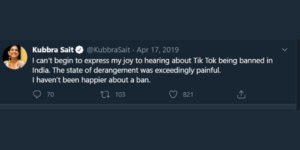
The criticism of TikTok seemed to similarly unite individuals on both sides of the spectrum. The initial calls to ban the app, including debates in the Tamil Nadu State assembly typified right-wing reaction to the perceived degradation of Indian culture by modern media. But several liberal commentators also chimed in with their disapprobation of the app’s encouragement of unproductive and silly behaviour. Thus, a similar argument was made albeit from different perspectives – the Right, as ever, took up cudgels on behalf of tradition, while the progressives mount a critique of taste.
Here, a further sense of obscenity is flagged. Why, for example, are the productions on TikTok considered offensive when the Bollywood templates to which they refer have become naturalized to the point of becoming banal? I would argue that TikTok is considered vulgar, not only because of the content of individual videos and their lo-fi, DIY aesthetic, but also, and this seems to be of essence, because the app encourages people to waste time and resources. This flies in the face of the old capitalist axiom – time is money! The spectre of such squandered productive capital is extended to the TikTok user himself, who as one journalist derisively remarked, represented the country’s proverbial “demographic dividend”. This is the millennial generation dubbed “the Dreamers” by reporter Snigdha Poonam, who comprise the largest potential youth workforce in history. Widely considered to constitute India’s prime economic advantage on a world stage, especially vis-à-vis neighbouring China, it is a demographic that has been ill-served by a slowing economy and diminished prospects of lucrative employment. Without a job, Indian youth are thought to spend endless, listless hours on TikTok, either creating or consuming mindless entertainment. And to add insult to injury, they are entrapped by an app owned by the very economic rival they were supposed to help edge out in global competition. TikTok, as an unofficial index of unemployment, unfolds in real-time the obscene spectacle of the attrition of national economic potential.
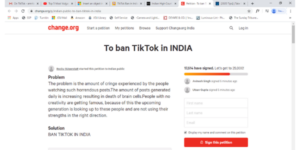
Change.org petition started by user Rocky Superstar. Screenshot taken by author.

Change.org petition started by user Adarsh Krishnaa. Screenshot taken by author.
The cardinal sin of TikTok, then, is revealed to be the way in which – to put it in the words of The New Yorker’s Jia Tolentino – it “doesn’t ask you to pretend that you’re on the Internet for a good reason.” Or it can be considered symptomatic of what The Economist reports of Internet use in India – that the poor are increasingly persuaded to come online in pursuit of pleasure rather than older developmentalist imperatives. But what such interpretations fail to take stock of is the way in which leisure activities increasingly encode a form of latter-day capital. TikTok, encapsulates the logic of a post-Fordist economic order, where the separation of work and non-work is increasingly disturbed by the colonization by capital of all aspects of life. The idea of play-as-labour is central to the use of TikTok by the small-town, vernacular user, who deprived of other avenues, is acutely attuned to the app’s productive possibilities. What an educated class bemoans as the decline of creative standards is then actually an admission of insecurity – of the repudiation of specialised knowledge and expertise, and the consequent, revolutionary opening of the gates.
To return at the end to the point with which I began, the censorship of TikTok elucidates its cultural meanings. The belated “discovery” of TikTok by a literate and otherwise media-savvy class indicates the way in which this class is actually out of step with the manner in which labour, capital and pleasure are mutually implicated in a ludic rather than utilitarian economic order. In the chasm between the public who only took stock of its impact after the ban, and its early adopters who are conspicuous by their absence in public discourse, the subversive potential of TikTok is emphatically registered.
References:
- Bagchi, Shrabonti. “TikTok users don’t care for your opinion.” In Mint Lounge, April 19, 2019. https://www.livemint.com/mint-lounge/features/tiktok-users-don-t-care-for-your-opinion-1555642988767.html
- Baishya, Anirban K. “Pornography of place: Location, leaks and obscenity in the Indian MMS porn video.” In South Asian Popular Culture, 15:1 (2017), pp. 57-71.
- Emmanuel, Meena. “‘The future of youngsters and mindset of children are spoiled’, Madras HC directs ban on mobile app TikTok.” Bar and Bench, April 3, 2019. https://www.barandbench.com/news/madras-high-court-ban-tiktok
- Ghosh, Poulomi.”5 reasons why I think TikTok should be banned.” In DailyO, February 22, 2019. https://www.dailyo.in/humour/pulwama-rss-5-reasons-why-tiktok-should-be-banned/story/1/29602.html
- Grover, Gurshadabad. “Why the TikTok ban is worrying.” In The Hindustan Times, May 2, 2019.https://www.hindustantimes.com/analysis/why-the-tiktok-ban-is-worrying/story-9Q7Gpv9t1Uxavd8hYJnjDO.html
- “How the pursuit of leisure drives internet use.” The Economist, June 8, 2019. https://www.economist.com/briefing/2019/06/08/how-the-pursuit-of-leisure-drives-internet-use
- “India TikTok Ban: App Removed From Google, Apple Play Stores.” Livewire.com, April 17, 2019. https://livewire.thewire.in/out-and-about/tiktok-ban-google-apple-play-store/
- Malhotra, Namita. Porn: Law, Video, Technology. Bangalore: Centre for Internet and Society, 2011.
- Mazzarella, William. “The Obscenity of Censorship: Rethinking a Middle-Class Technology.” In Amita Baviskar and Raka Ray eds. Elite and Everyman: The cultural politics of the Indian middle classes. London: Routledge, 2011.
- Poonam, Snigdha. Dreamers: How Young Indians Are Changing Their World. Penguin Random House, 2018.
- Pundir, Pallavi. “Indian High Court Wants to Ban Chinese App TikTok for ‘Encouraging Pornography’.” Vice.com, April 4, 2019. https://www.vice.com/en_in/article/qvy7zp/indian-high-court-ban-chinese-app-tiktok-for-encouraging-pornography
- Sathe, Gopal. “From TikTok And PUBG To Github And Reddit: Behind India’s Internet Bans.” Huffpost, April 16, 2019.
https://www.huffingtonpost.in/entry/tiktok-pubg-github-reddit-india-internet-ban_in_5cb45248e4b082aab08886f2?guccounter=1&guce_referrer=aHR0cHM6Ly93d3cuZ29vZ2xlLmNvbS8&guce_referrer_sig=AQAAALALS8NIDcByRm8u752gzbMcf3y0GptpmXekXgihUb2C1JIsd2ip2XYu698TtzJ80Ts1J5PQwFOXMCQdGgTJykD9jvxqZ1iQ4oeFhSenRSMuWvg7BccyRjNUifU8MJczzGL0e_JoO8B06x1DnhpYeQJ7XUs6sr5zLNsUs-zcNqtO - Shaviro, Steven. “Accelerationist Aesthetics: Necessary Insufficiency in Times of Real Subsumption.” e-flux Journal #46, (June 2013).
- Tolentino, Jia. “How TikTok Holds Our Attention.” In The New Yorker, September 23, 2019. https://www.newyorker.com/magazine/2019/09/30/how-tiktok-holds-our-attention
About The Author
Amrita Chakravarty is a graduate of the School of Arts and Aesthetics, JNU. A Cinema Studies student, her MPhil dissertation entitled “Expanding the Archive: Re-iterations of Film(i) History in Contemporary Media, Art and Cinema” looked at the diverse uses and manifestations of film history prompted by the proliferation of digital archival practices. Drawing from the fields of retro and nostalgia studies, and media archaeology, her research included a case study of social media, specifically digital platforms like TikTok and Dubsmash as new sites of fan activity and film discourse. She has been at Critical Collective since 2017, where she is now a Senior Researcher in charge of CC Cinema. She has previously written for BLink and ArtDose magazines.
Karagattam: The Good, The Bad, The Ugly
Since the times of Silapathikaram,[1] Karagattam has been extensively practised as an invocation to the village deity Mariamman, to bless the lands with rain.[2] Karagattam literally translates to “pot-dance”. Karagam is a decorated brass pot which is sometimes personified as the deity and is named Sakthi Karagam. Pots with simpler decorations called Atta Karagam are used in dance. Karagattam is accompanied by the spirited folk tunes of Naiyandi Melam.[3] Many folk artists believe that over the course of history, Atta Karagam became a common feature of temple celebrations[4] along with other folk performances.
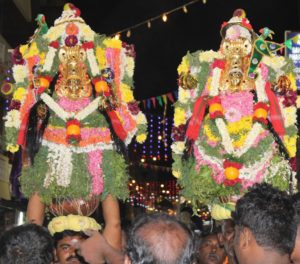
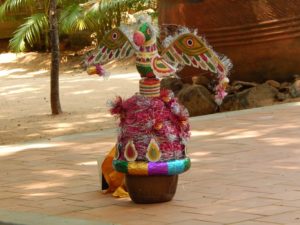
Image: (Right) Image of Sakthi Karagam (Left) Image of Atta Karagam. Source WikiCommons (Right) | Blog – Local Newspaper in Porur (Left)
In July 2016, the Madras High Court mandated the avoidance of “obscenity” in Karagattam performances.[5] They laid down conditions to be abided if the organizers of such performances wished to host any “Dance and Music” evenings. This essay explores the possible reasons that brought this folk form with over fourteen hundred years of history under the judicial purview.
DUALITY OF KARAGATTAM
Oral traditions indicate that Karagattam evolved from the practice of head priest fetching pots of water for worship at the temple. The delicate act of balancing the pot on their head created the ritual—Sakthi Karagam. Karagattam came into existence when more movements were added to this. Initially, only the head priest danced with the decorated Karagams. Over time, when other male members joined the celebrations, Atta Karagam came into existence. Performers often adapted to the local dialects and a typical repertoire was structured as mentioned below[6]:
- Kumba Attam: Salutations and introductions for the evening.
- Mookaayi Vesham: The artists dress-up as the elderly—dance and talks wisdom.
- Kuravan-Kurathi Vesham: The artists perform as a couple talking about current affairs amongst others.
- Nalla Thangaal Kathai: The main performance commences, usually relating to issues pertinent to social awareness.
- Pei Attam: The artists perform to fast-paced beats, often entering a trance.
- Mangalam – The final performance of the evening, upon which the rituals conclude.
From the repertoires, the Kuravan-Kurathi Vesham (gypsy) gained popularity in small villages across the districts of Tamil Nadu including Villupuram, Madurai, Thutukudi, and Tanjore. The Kuravan-Kurathi dance performance portrays artists as sharp-witted couples discussing current affairs, politics, and social issues. With the increase in audiences’ interests, it became a stand-alone full-length performance.
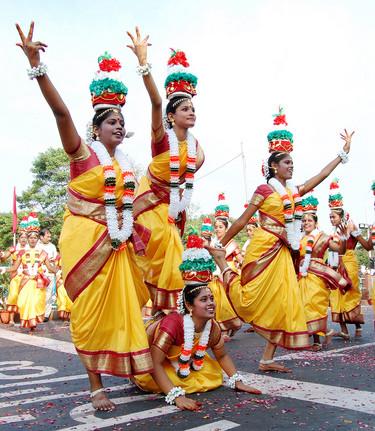
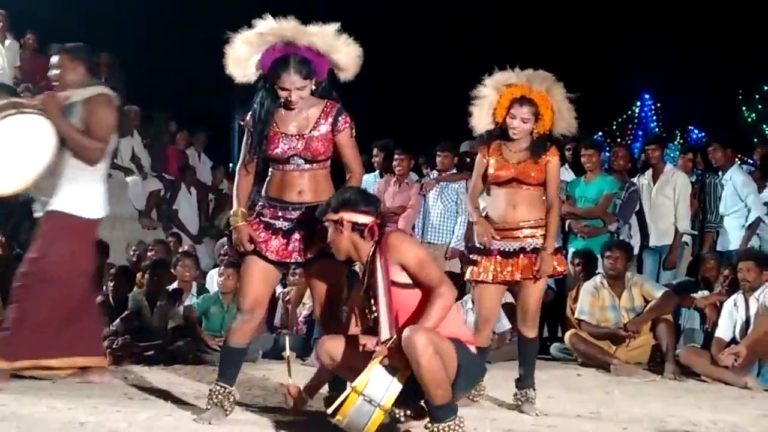
Image: Image of Kuravan Kurathi Attam | Source YouTube Thumbnail
To ensure that the audience stays for the duration of the performance through the night, it started to become more “entertaining”. Slowly the aspect of dance in the performance receded and it took the form of skits comprising dialogues laced with double entendres*; the dancers interacted with musicians with suggestive insults and flirty conversations*. Over time they also added sexually suggestive and gyrating displays*. The use of karagam and traditional dancing was reduced. The attire of the womxn performers (female and transgender) turned skimpy – shorter skirts, highlighted bosoms, exposed midriffs with a lot of sequins, frills, and sometimes even a decorated headgear. Even though, it should have been called as Kuravan-Kurathi Attam(KKA),[7] the troupes fearing low audience turnout and to secure performances, retained the name of Karagattam.
Current day searches for Karagattam on YouTube shows two distinct forms, unmistakeably differentiating KKA from Karagattam. Typically KKA videos are titled “Very Hot” with sexually suggestive thumbnail images/stills.
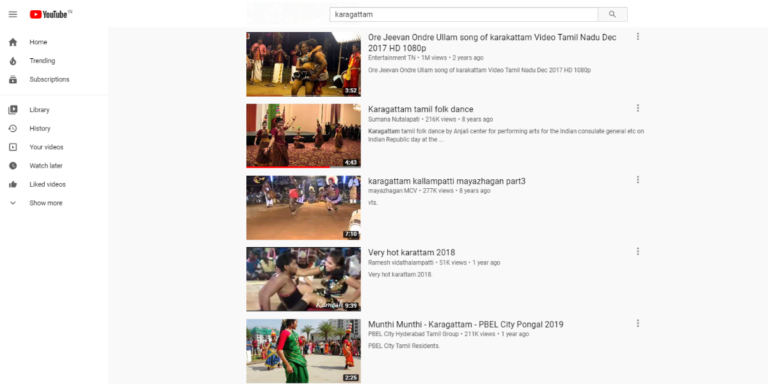
Image: YouTube screen grab of Karagattam search results
Erotic Narratives
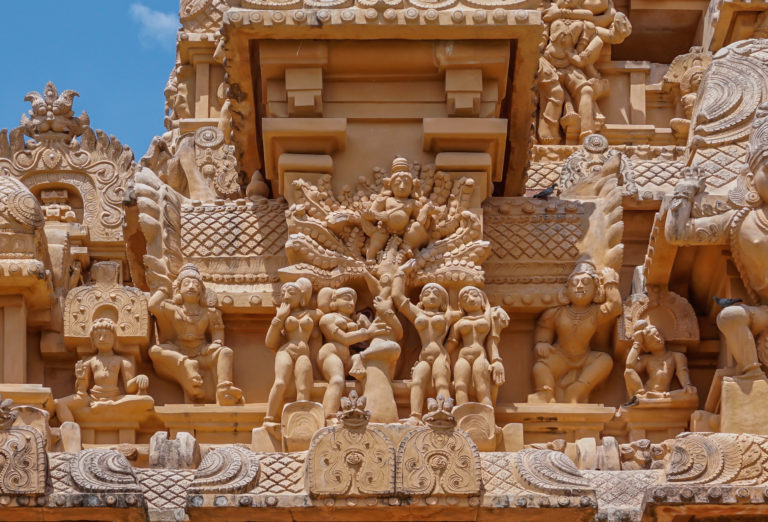
Image: Image of Kalpa Vriksha as seen in Tanjore Big Temple | Source WikiCommons
Erotic narratives are common in Hindu pantheon—they manifest as sculptures and form a major part of literature. A large part of bhakti poetry has erotic references which, usually is blindsided by those who read/recite them. Through moral judgements and conditioning of “modesty and indecency”, most communities slowly modified and moulded perceptions of eroticism and vulgarity.[8] While eroticism was considered an integral component of Bhakti and of higher aesthetics, vulgarity was cheap and vile. Women in general, were expected to keep their heads low, wear loose-fitting clothes to not expose their bodies, and talk in hushed tones. However, the female KKA performers danced and spoke, unfettered by these notions. The traditional society shamed the performers for being polluted and filthy. Their skin colour, caste and social class made them vulnerable targets and were deemed “characterless and prostitutes”. The normalization of shaming made it easy for men in society to look at them as objects of sexual desire. The society shamed womxn (performers and non-performers) to live in the mould of patriarchy, where female KKA performers were cited as examples of how not to be. Through the shaming patriarchy establishes a structure of power that allows men to get away with physical violence, and sometimes rape that happens outside the performance arena. Instances of violence against these womxn are brushed under the carpet as they are “asking for it”.
The society and audience seemed to forget that the bawdiness of KKA stems from the performance and not the performers.[9] The subtle eroticism over time changed to sexual innuendos, explicit insults, and suggestive acts of varying degrees of raunchiness, which led to a cheering crowd. The form provided comic relief for men, highlighting Freud’s hypothesis that the enjoyment of a joke is connected with what is repressed in a society.[10] The inhabitants of villages saw KKA as a coming-of-age experience for adolescent boys, and normalized KKA performers to be eyed as “things to satiate male desire”. Amidst a patriarchal society, nobody questioned any of this, including the treatment of the performers. The performers had no respect in this society and their privacies were constantly violated.
Audience and Social Encounters
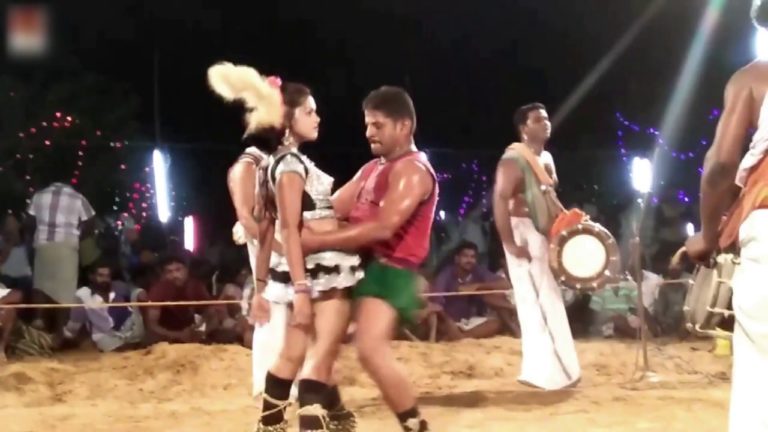
Image: YouTube Thumbnail – Sexually Suggestive and Gyrating Displays | Source YouTube Thumbnail
The audience that KKA caters to is predominantly male—adolescent boys, young, and middle-aged men. The organizers of KKA have clear requirements specific to female body exposure, the number of womxn performers, the duration, and the lewdness of the performance. Each of these factors affect the remuneration. The most respected (powerful/elderly) men in the village preferred not to be seen at KKA, and would promptly leave after the inauguration. These performances did more than just cater to the pleasure of cis-heterosexual men; they were spaces where gestures of power took place. Political parties hosted KKA to entice men to cast the votes in their favour. The performers constantly shamed and shunned, male gaze had driven KKA to the murky depths of misogyny. Despite regular incidents of aroused, drunken men attacking the womxn performers, the organizers take no responsibility of their safety and well-being. These performances, essentially, have become a local Tamil Nadu version of strip-tease without any of the protections extended to those who perform.
Artists
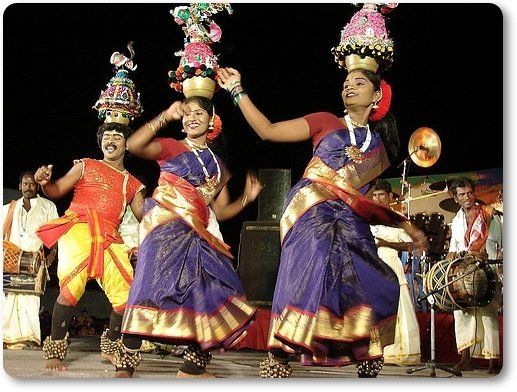
Image: Image of Traditional Performance | Source Pinterest
The artists who practise the traditional form are proud of their form, and often do not identify with KKA as a practice. The form of Karagattam has transformed over the years—traditional performers hold their karagam at all times; the female performers wear a saree; they dance and incorporate acrobatic movements during the show, with less or no space for skits. Unlike KKA, the organizers have little say over any aspect of traditional performances.
The artists succumb to the demands of their social world to sustain themselves. Many female KKA performers do not want their children to perform. To distance themselves from being objectified, they call their work as a “service” to lust.[11] Karagattam artists, especially women, receive meagre payments as income.[12] An artist earns up to INR 2000 per performance. Optimistically one performs for 50 nights a year. Even after many jobs, the performers find themselves caught in a cycle of debt. On the other hand, a KKA performer earns more than a Karagattam performer, typically around INR 3000 per performance with more opportunities.[13] Those who perform the KKA are usually related, where they would have started young to earn for the family. Unfortunately, family and economic circumstances bind them to the practice.
Predictably, many artists welcomed the regulations laid by the Madras High court. It included guidance on the timing, content, and attire. It also made the presence of policemen compulsory. While this move is cheered, it dented their income and opportunities to perform. The traditional artists claim that many enter KKA for money and have no Karagattam training. Traditional practitioners choose to remain disassociated from KKA due to its insinuations.
In a nutshell, with most of KKA being performed in interior parts of Tamil Nadu, legal interventions are at best a stop-gap measure.[14] Discussions without judgment and censure, along with active participation of the state government is essential to protect the interests of artistes.[15]
Header Image: (Right) Still from Kuravan-Kurathi Attam (Left) Image of Traditional Form of Karagattam. Source YouTube Thumbnail (Right) | Blog – India Link (Left)
Sexually Suggestive Content
[1] Silapathikaram is among the earliest and crucial texts from Sangam literature (5th-6th century).
[2] Krishnadas, Priya. Folk Performing Arts: Tamilnadu. Chennai, TN: Madras Craft Foundation, 2008.
[3] Nayandi Melam is the musical ensemble which includes percussion instruments – Parai, Udukku, and Thavil, and wind instrument – Nadaswaram.
[4] Temple Celebrations are called Kovil Thiruvizha which occur in the tamil months of Chitthirai (Apr-May) and Aadi (Jul-Aug). The temple celebrations take place through the night with various music and dance performances for the devotees. Depending on the customary practices, the celebrations usually ends during day break with the ritual.
[5] Imranullah S, Mohamed. 2016. “Avoid Obscenity in ‘Kathakali’ and ‘Karagattam’: Madras HC.” The Hindu, July 18, 2016. https://www.thehindu.com/news/cities/Madurai/Avoid-obscenity-in-‘Kathakali’-and-‘Karagattam’-Madras-HC/article14495864.ece.
[6]Dharmalingam, B.,et al. “Dance Formof Karagattam-TheRegional Folk Dance inTamil Nadu.”ShanlaxInternational Journalof Arts, Science andHumanities, vol. 7, no. 1,2019, pp. 71-75
[7] “Plea to Ban ‘Kuravan Kurathi Aattam.’” The Hindu, September 25, 2019. https://www.thehindu.com/news/cities/Madurai/plea-to-ban-kuravan-kurathi-aattam/article29510912.ece.
[8] NARAYANAN, RENUKA. “Madras HC’s View on Obscenity in Kathakali, Karagattam Seems Obscene.” Daily O, July 26, 2016. https://www.dailyo.in/politics/madras-hc-kathakali-karagattam-south-india-p-devadass-sadir-bharatnatyam-aadi-mariamman-tamil-nadu/story/1/12010.html.
[9] Karthikeyan, Divya. “Karakattam: A Folk Art Languishing in the Web of Morality.” The News Minute, August 1, 2016. https://www.thenewsminute.com/article/karakattam-folk-art-languishing-web-morality-47443.
[10] Henderson, Schuyler. “The Joke and Its Relation to the Unconscious (Review).” https://med.nyu.edu/, March 20, 2008. http://medhum.med.nyu.edu/view/12852
[11] Diamond, Sarah Louise, “Karagattam: Performance and the politics of desire in Tamil Nadu, India” (1999). https://repository.upenn.edu/dissertations/AAI9937718
[12] Basu, Soma. “A Care for Karagattam?” The Hindu, June 11, 2014. https://www.thehindu.com/features/metroplus/society/A-care-for-Karagattam/article11642228.ece.
[13] “Dalit History Month.” Dalit History Month (blog). Medium, April 21, 2020. https://medium.com/@dalithistorynow/swetha-surviving-transphobia-thriving-through-dance-4d25fe67fe21.
[14] “Maridurai vs The Superintendent Of Police on 27 February, 2019,” February 28, 2019. https://indiankanoon.org/doc/128862852/?type=print.
[15] Thanks to Vishwa Bharath (percussionist, folk artist and trainer based in Chennai) and Thanjai G Raju (3rd generation folk-artist who has his own crew in Chennai) for sharing their insights on Karagattam.
Author Bio
Lakshmi Venkataraman is a freelance writer and arts manager based out of Chennai. She has worked on projects with the Prakriti Foundation, the Chennai Photo Biennale and been part of teams at the Bangalore Lit Fest, Nalandaway’s Youth Summit and Fundraiser, BK50, Natya Darshan and other productions/events. She writes content for business houses and start-ups regularly. Her love for stories prompts her to put up flash fictions, and she sometimes dabbles around in poetry as well. Marrying both her passions, she is now exploring art writing.
The Queen of Gulabi Talkies
Every Sunday at 7pm, the latest Kannada cinema, fresh off the talkies, would play on Doordarshan, after the classical music program. An event my grandfather frowned upon, since such ‘anti-intellectual’ activity would corrupt our moral fibre (which only greatly increased our fascination). Despite his tacit disapproval – stylish ambassador cars screeched in a hot chase, ladies picked up phones and said ‘Hello Operator’ to Rajkumar in bell-bottoms, Rebel Star Ambarish played a pink-suited secret agent. As a 10-year-old, I searched for myself in the leading ladies of these blissful Sunday movies of the late ‘80s and early ‘90s. After an initial burst of promise, all of them annihilated their personhood to become good wives, mothers or sisters. To my utter disappointment, they sacrificed regularly, won over evil mothers-in-law through goodness, were stalked and conquered, and gave birth to baby boys post their ‘first nights’. They upheld every patriarchal definition of womanhood, chastity, and virtue. It was at this time that Umashree burst into my life and I vividly recall the shock of first watching her on screen.
In Ravichandran’s ‘Swabhimaana’ (1985) Vijay falls in love with Vani, during a prize giving ceremony where Vani has won first place in Debate, Sports, Embroidery, Drama, Painting and Drawing. Smitten, Vijay marries Vani, who proceeds to ably manage his estate, accounts and business, alas drawing Vijay’s jealousy. Ignored by the very man she loves, Vani tries to bring a change in him, as Vijay plays squash and rejects her tear-filled appeals. In the same film, Umashree plays the estate maid, with an endearing husband (played by her favourite co-actor NS Rao), who is cursed with impotency, an affliction she is resolved to cure. In her comedy track, Umashree is firmly in charge of making her husband the stallion he is meant to be, blows the pungi to ‘wake his snake’, cooks him meals of sorekai (snake gourd), buys tonics guaranteed to ‘make him a man’. I vividly remember the scene where Umashree stands provocatively at the door of their bedroom, after one such attempt. NS Rao sits coyly on the bed like a bride on her ‘first night’. Umashree, full of desire, wrestles him onto the bed which breaks and as the lights go out, we hear NS Rao giggling, saying ‘spare me, dear lord’.
Although never cast as the lead, Umashree had a monopoly in Kannada cinema since the early 80’s to the late 2000’s. She starred in over 400 films. There was no actress who was even a distant second. In an interview with Suvarna Kannada, she says “I was never the heroine, but for several years, the films ran because the public didn’t ask who the hero or heroine was. They asked, ‘is Umashree in it’”
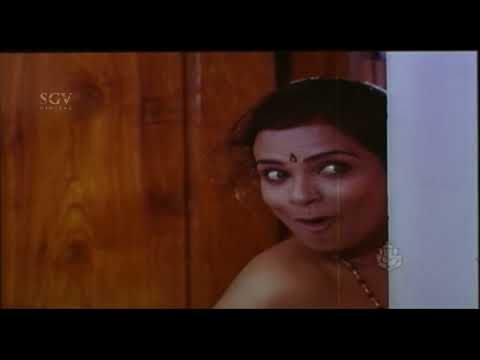
Image:Umashree ‘controls’ costar Sihi kahi Chandru in film ‘Challenge GopalaKrishna’ (1990)
Umashree’s characters weren’t the cabaret/nautch girl, whose main purpose in the narrative was to take a bullet for the Hero. Nor was she the younger sister whose rape served a plot pivot for the Hero to turn into ruthless avenger. Umashree’s characters knew the negotiation of intimacy, and what she must do to get the best deal. The roles Umashree played were distinct. She was usually single, desirable, surrounded by men, unabashedly aware of her sexuality and the effect it has on those around her. Always occupying the side track, her characters mouthed sharply comic dialogues imbued with double entendre. The characters she portrayed were capable of looking after themselves, freely using their sexuality as a means of negotiating with the world.
The roles Umashree played were beamed into our TV sets, normalizing her distinct brand of comic innuendo, making a place for vulgarity in middle-class homes. Although humbled in the end, unlike the heroines she shared screen time with, Umashree called out the vulgarity of patriarchy by refusing to internalize it. She instead exposed its crudity by externalizing it with skill and honesty that simultaneously made her both ‘cheap’ and immensely successful. At the end of a movie when ‘The Beginning’1 flashes on the screen over picture-perfect domestic bliss, Umashree’s characters would be comically grumbling, winking at a new catch or restarting an old feud with the husband while the heroine makes peace within patriarchy. When Umashree’s films beamed into our homes, I was old enough to understand why my grandmother had taught herself to laugh soundlessly – to never wear all her pearls, since even at 72, her being ‘too attractive’ made my grandfather uncomfortable. Something in Umashree’s bawdy vulgarity felt reassuring. Although unintended by the film makers, her roles were an alternate to the punishing lives of the lead heroines. Maybe no one else saw it that way, but she stood out in my childhood, in a blaze of gaudy blue eye-shadow.
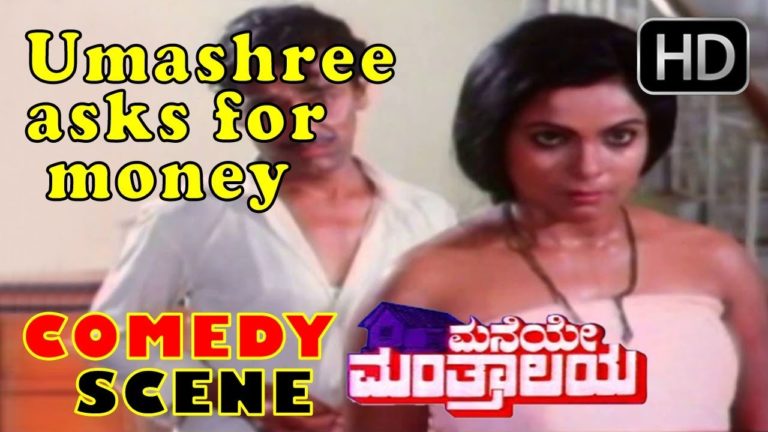
When I encountered Umashree again – it was in a world where I was a theatremaker (a profession that would have horrified my grandfather) researching female performers in the archives of Prakash Garud’s extensive documentation of North Karnataka’s company theatre history. During 1970-90 – a period of decline in Kannada’s illustrious company theatre, as it waged a losing battle with the talkies, a new set of possibilities emerged. Enabled by its low maintenance nature, the frontline comedy took on a new significance. In this format, female roles went through a radical change as the appearance of the ‘loose woman’ as a comic figure started to gain popularity. It was here, at this particular point in history, I found Umashree again. In the late 70’s, with some experience in rural and amateur theatre, Umashree had turned to commercial theatre to support herself as a young single mother. Abandoned by her husband, commercial theatre became her profession.
In Huccheshwara Natya Sangha’s commercial hit ‘Bus Conductor’ (1979-90), Chenni, is a side character, the daughter of a Khanavali owner. With Umashree taking on this role, her popularity as Chenni rose to such an extent that ‘Bus Conductor’ was renamed ‘Khanavali Chenni’. All the characters from the original play were relegated to side characters and ‘Khanavali Chenni’ became the season’s biggest commercial success. With this success Prakash Garud recalls how Umashree would be called by panic-stricken managers when their shows started to lose audiences – a mere mention of Umashree on a company poster would ensure a full house. Around the time of her success as a commercial theatre actress, Umashree made another bold move by starring in Kashinath’s Anubhava (1984), a Kannada adult film. She essayed a role “with grey shades” which no actresses were willing to portray. The film went on to become a blockbuster, catapulting her into talkies-theatre dual stardom.
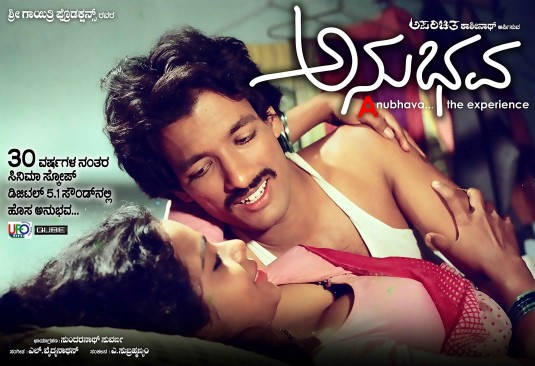
Umashree, throughout her career, drew inspiration from her folk theatre (Gramya Rangabhoomi) roots and her immersion in professional theatre circuits of North Karnataka. It was from here that she crafted her roles, with an array of authentic accents, costumes and behaviours – from the flower-seller sporting a Chamrajnagar accent to the maid with a North Karnataka twang to the suave college lecturer peppering her dialogues with English phrases of playful admonishment ‘Oh you naughty naughty!’. Through her professional theatre experience, she brought to life characters firmly rooted in the Kannada cultural imagination, a quality that aided her immense popularity as an actress.
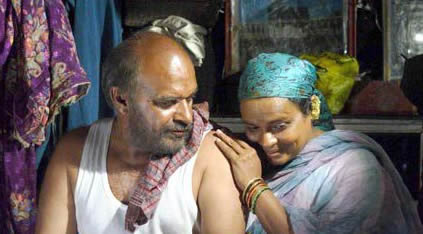
The third time I encountered Umashree was in 2010, in a retrospective of auteur Girish Kasarvalli’s films. It was in art house regional cinema, surrounded by khadi sarees and polite conversation I saw her again. The Queen of ‘Gulabi Talkies’, playing a midwife in her 50’s, Umashree made a casting coup, bringing alive a woman whose sexuality was as central as her character. At a time when her contemporaries, made irrelevant by age and lack of roles, were absent from the silver screen, Umashree won her first National Award for Best Actress (2008). A few years after, in 2013 Umashree became Karnataka’s Minister for Kannada and Culture.
By now, I had learnt not to be surprised.
Notes
- Kannada family dramas of the 80s and 90s ended with all the actors gathering while “The Beginning” flashed as a title on the last scene. This was to indicate that life comes to a full circle.
ABOUT THE AUTHOR
Sharanya Ramprakash is a theatre maker whose work experiments with language, tradition and gender. She writes, acts, directs and collaborates with a range of forms, communities and theatre makers across local, national and international locations. Sharanya is an INLAKS scholar and member of Lincoln Centre Director’s Lab, New York. She is one of the founders of theatre collective, Dramanon, Bengaluru which produces new writing and nurtures emerging voices.
Her latest work includes Akshayambara, a critical exploration of gender and masculinity in Yakshagana with a contemporary feminist lens. Mythology Upon the table, that interrogates Homer’s Odyssey, with a queer, feminist, Asian lens directed by Baboo Liao is currently touring Taiwan. Her Kannada play, Nava, created in collaboration with 9 transwomen from Aravani Art project and I am not here – performed as an an 8 step guide on how to censor women’s writing, devised by her and Ronita Mookerjee and directed by Deepika Arwind are also currently in performance.
Header Image:Umashree in Sididedda Gandu (1990) Photocredit Chitraloka
LOGIN to see more
To see all the content we have to offer, login below
OR
Don't have an account?
REGISTER FOR FREE
REGISTER FOR FREE
Registration is completely free, stay connected to Serendipity Arts

